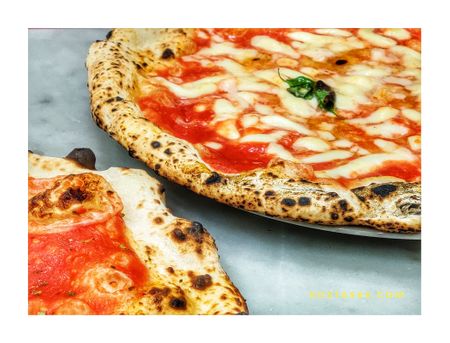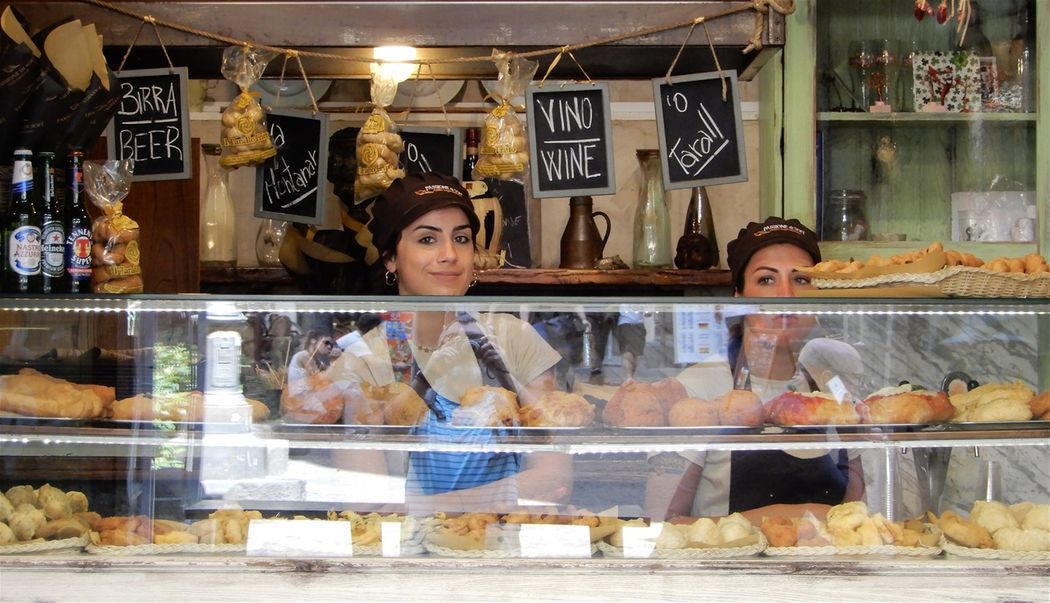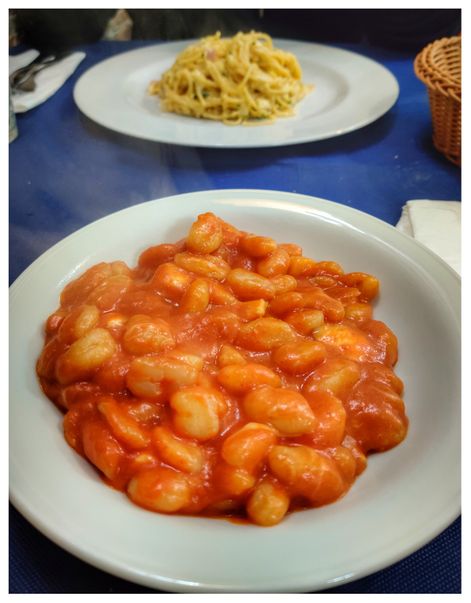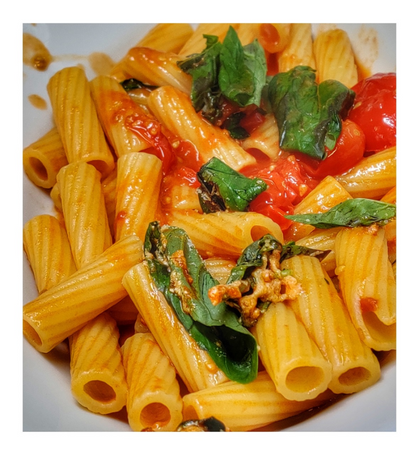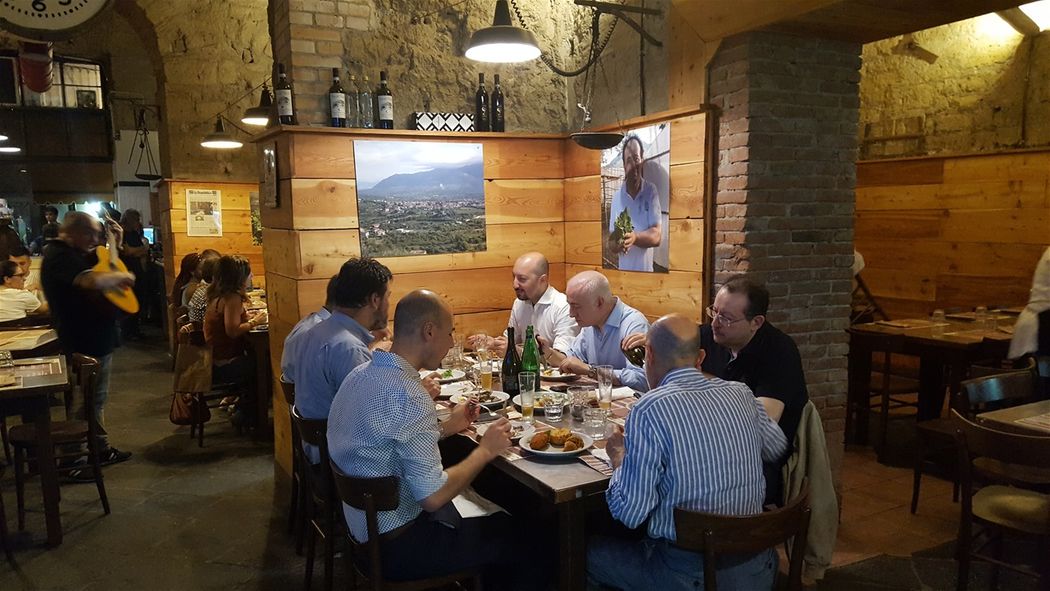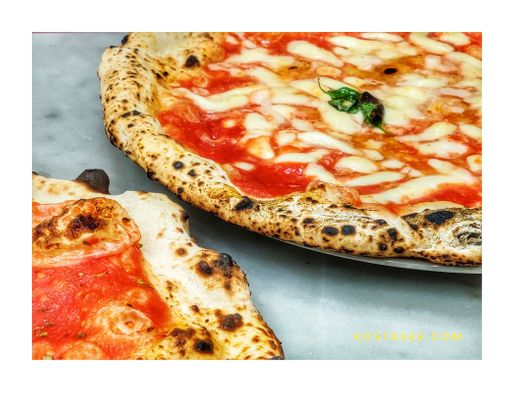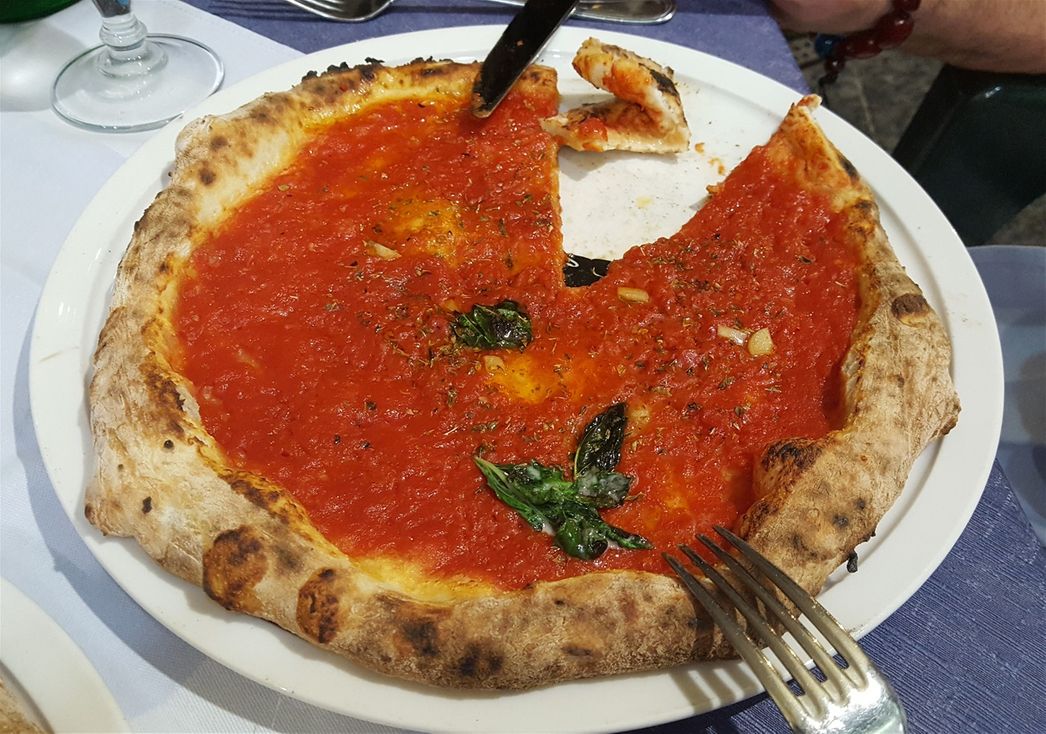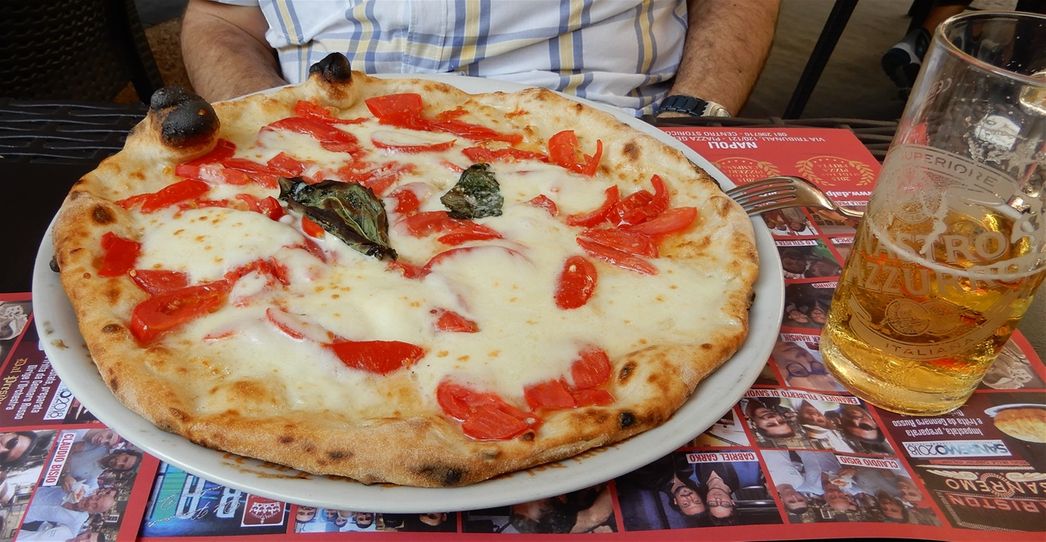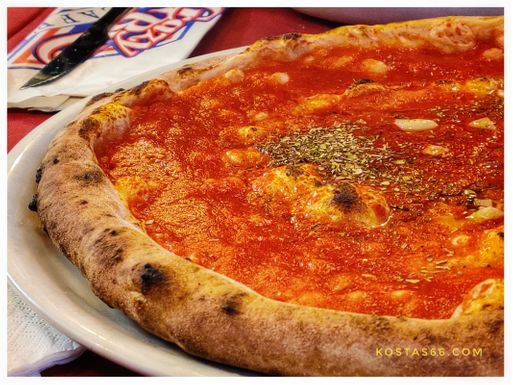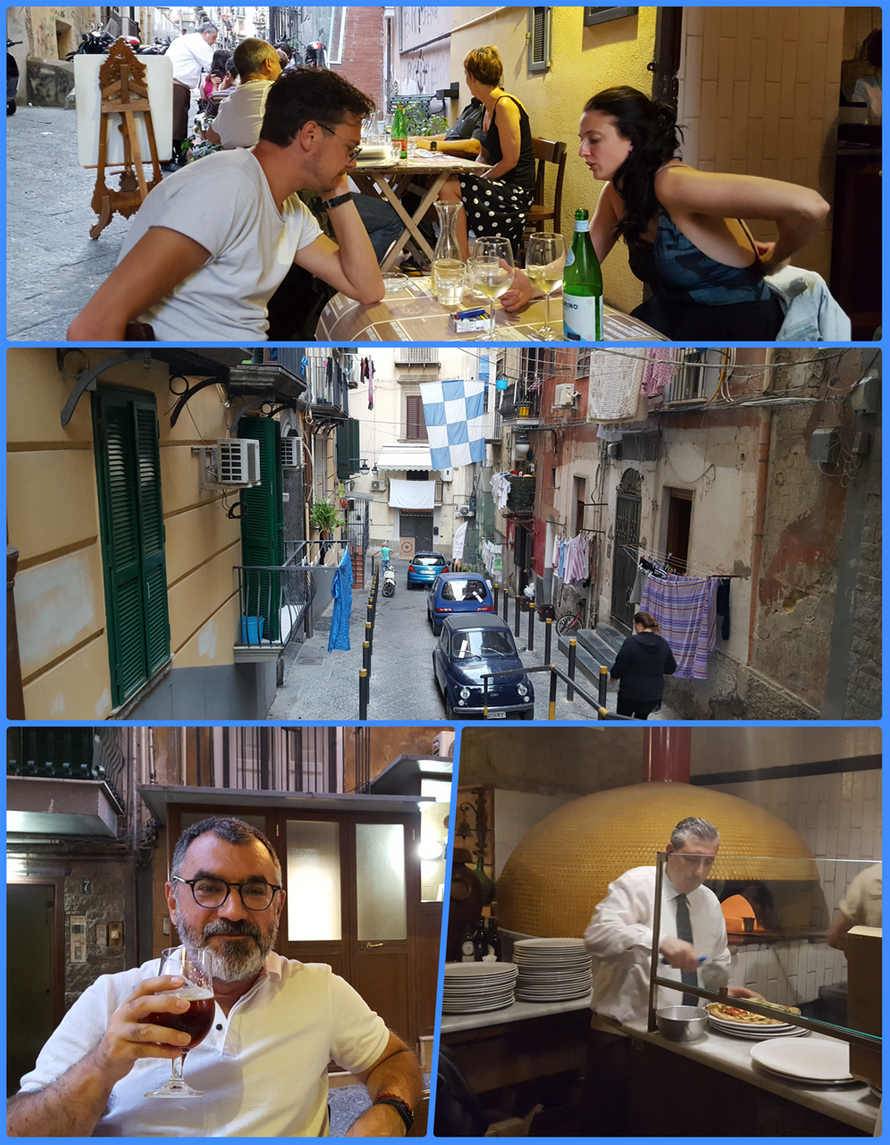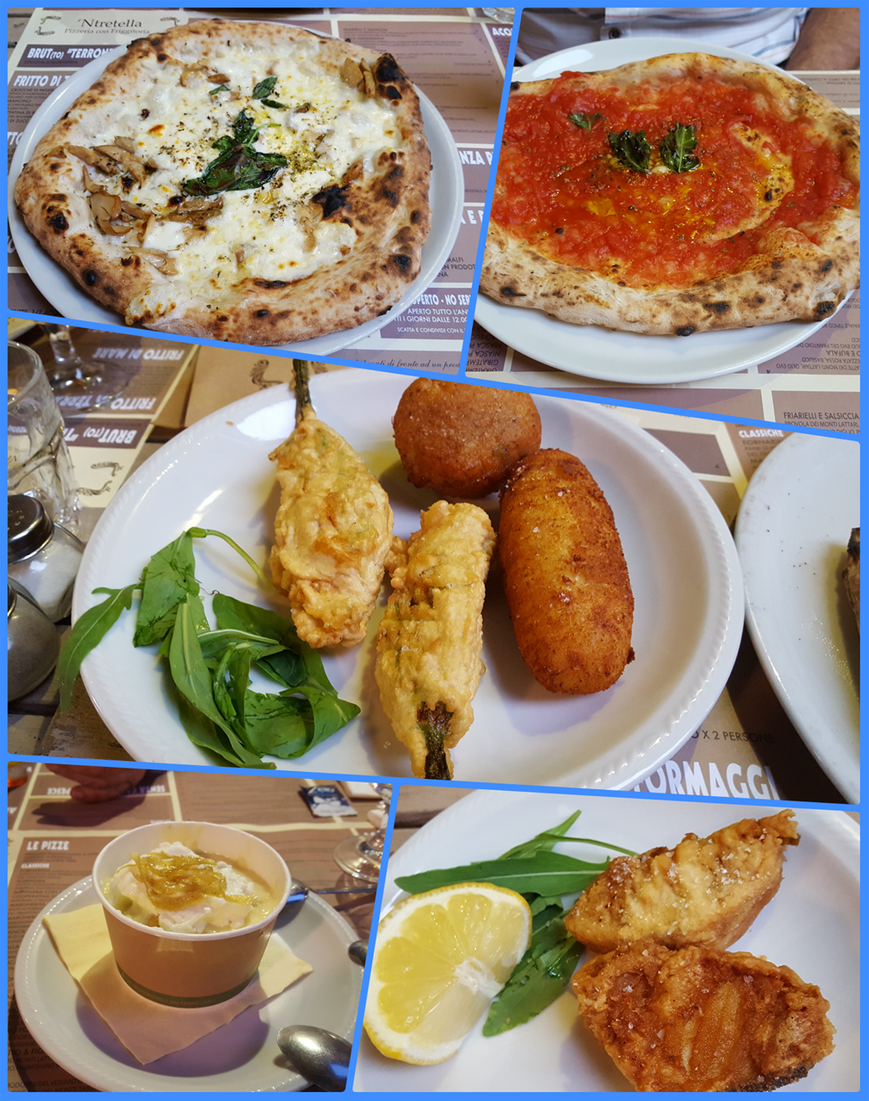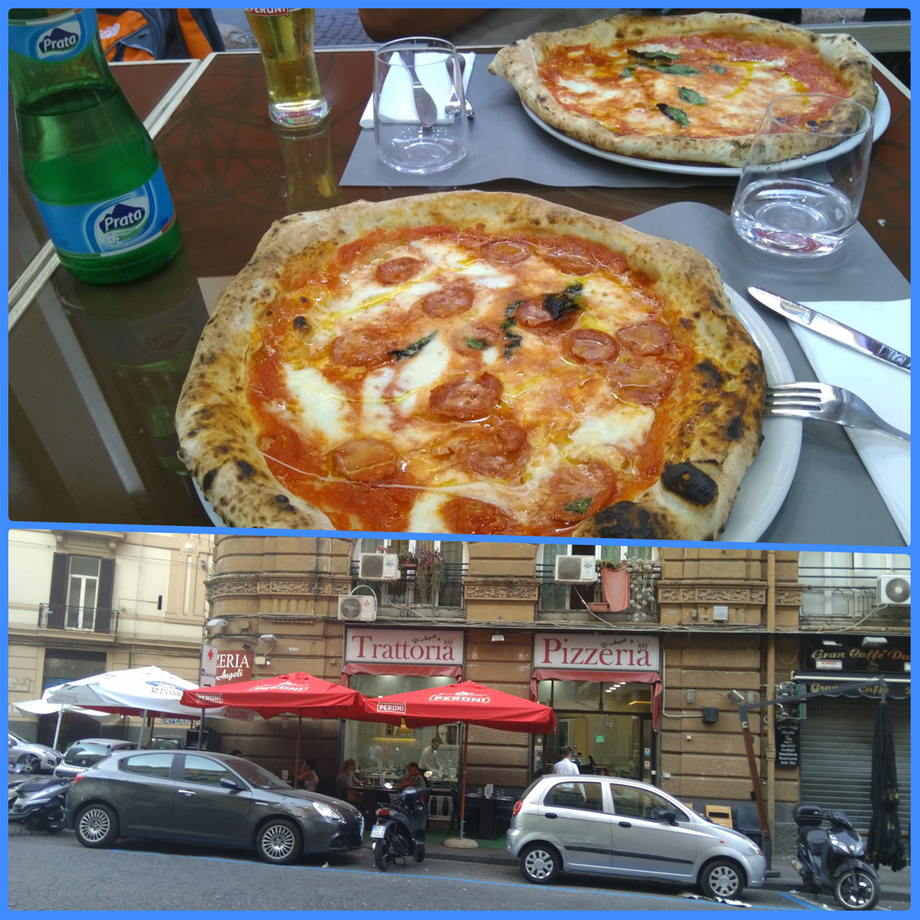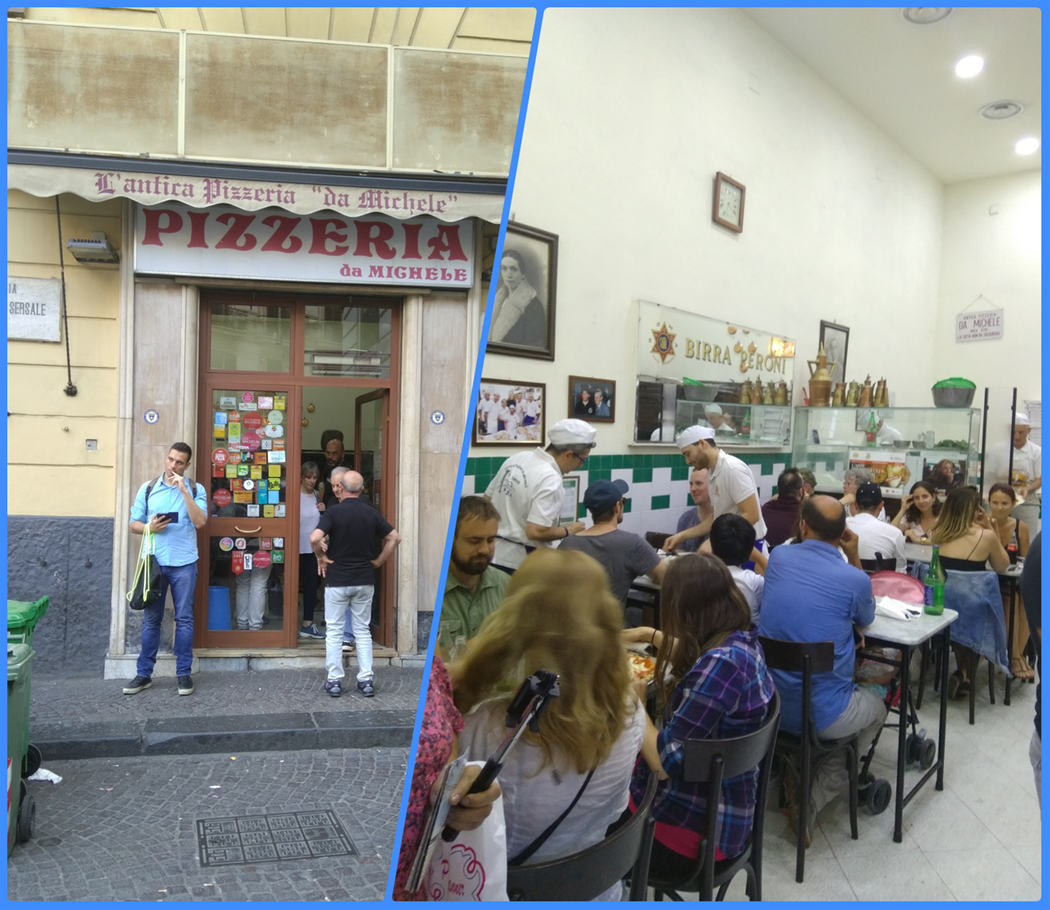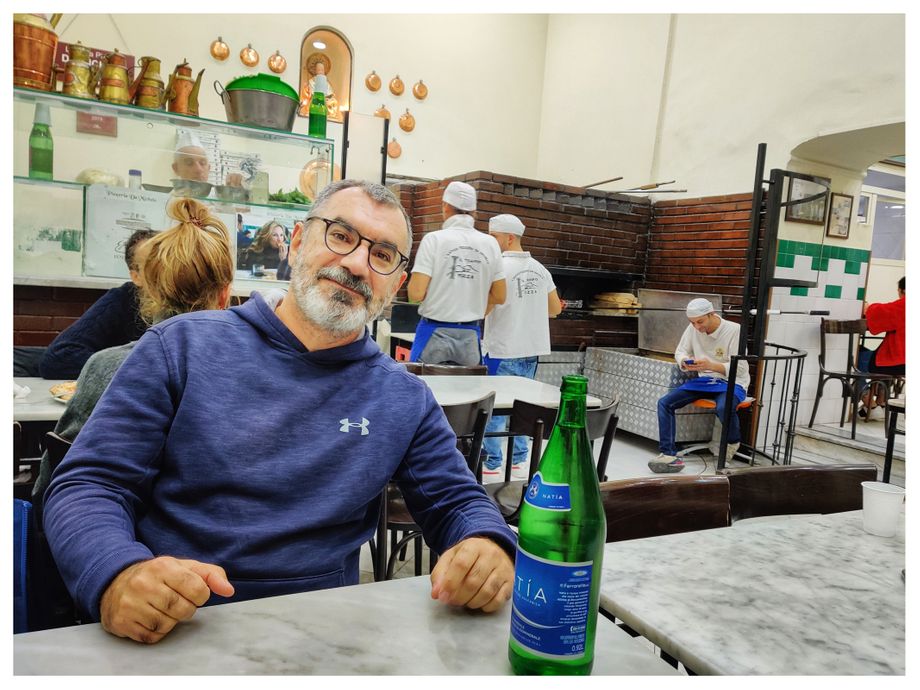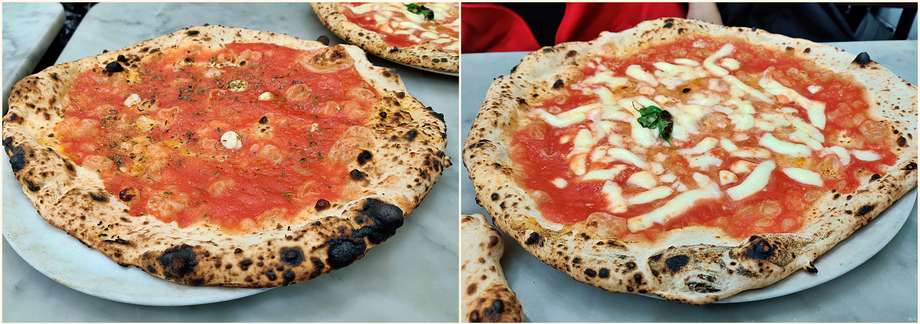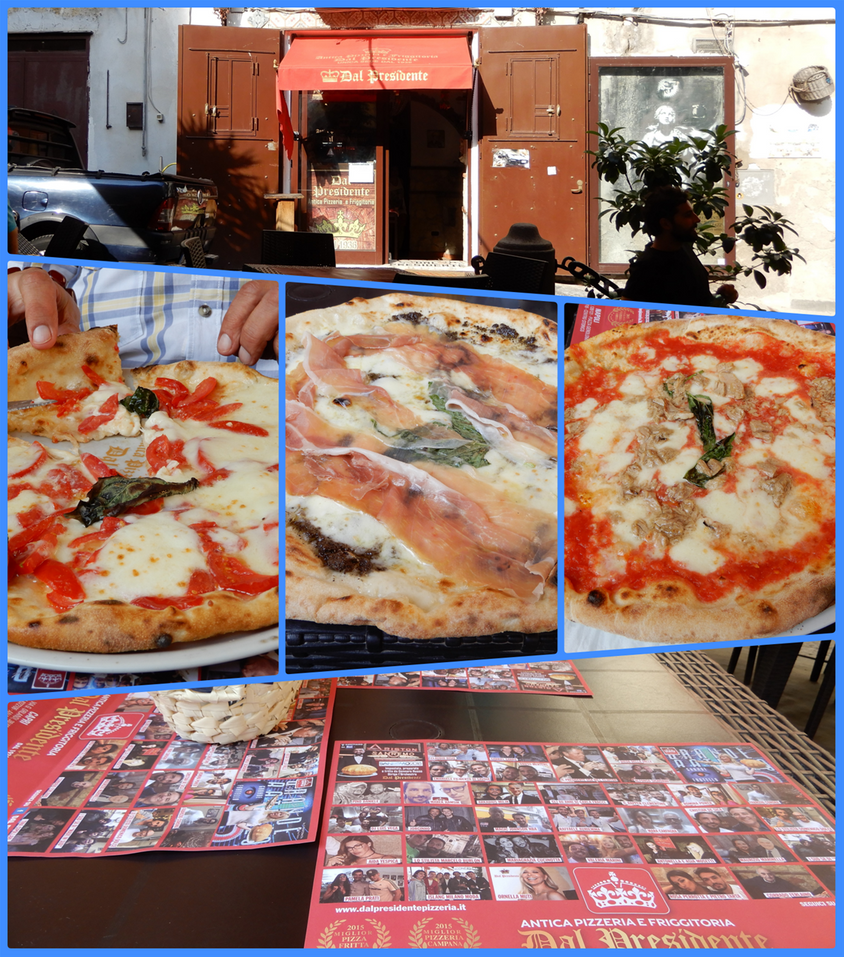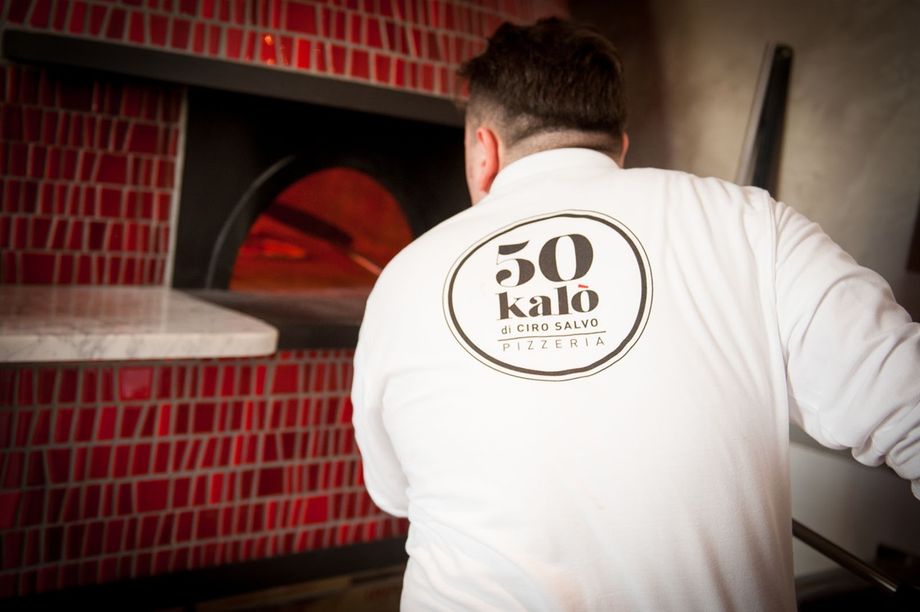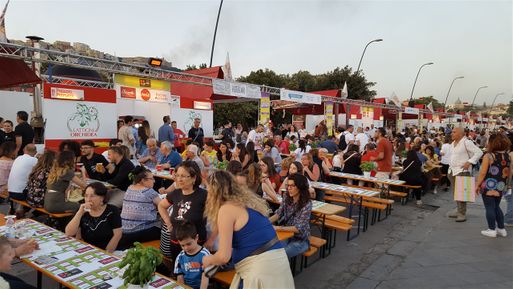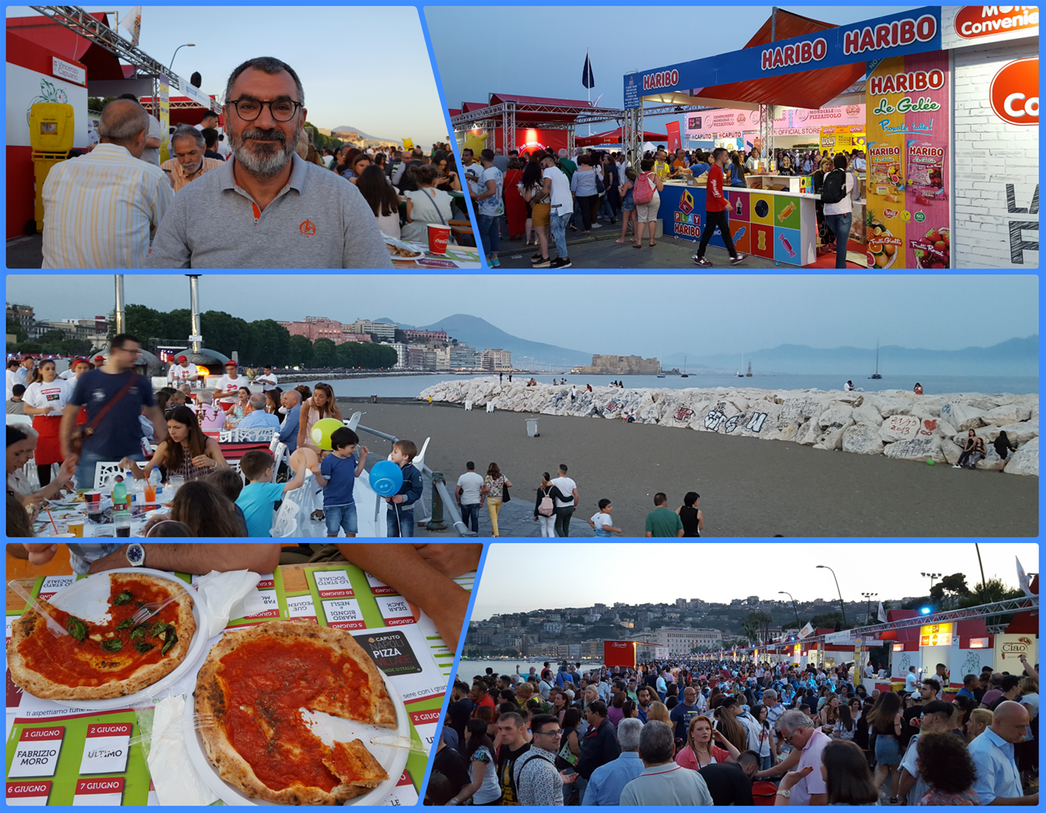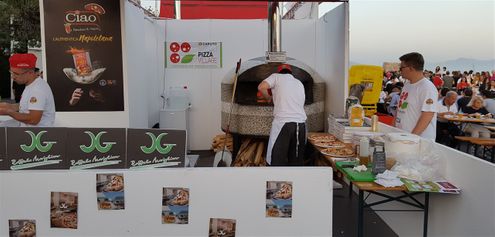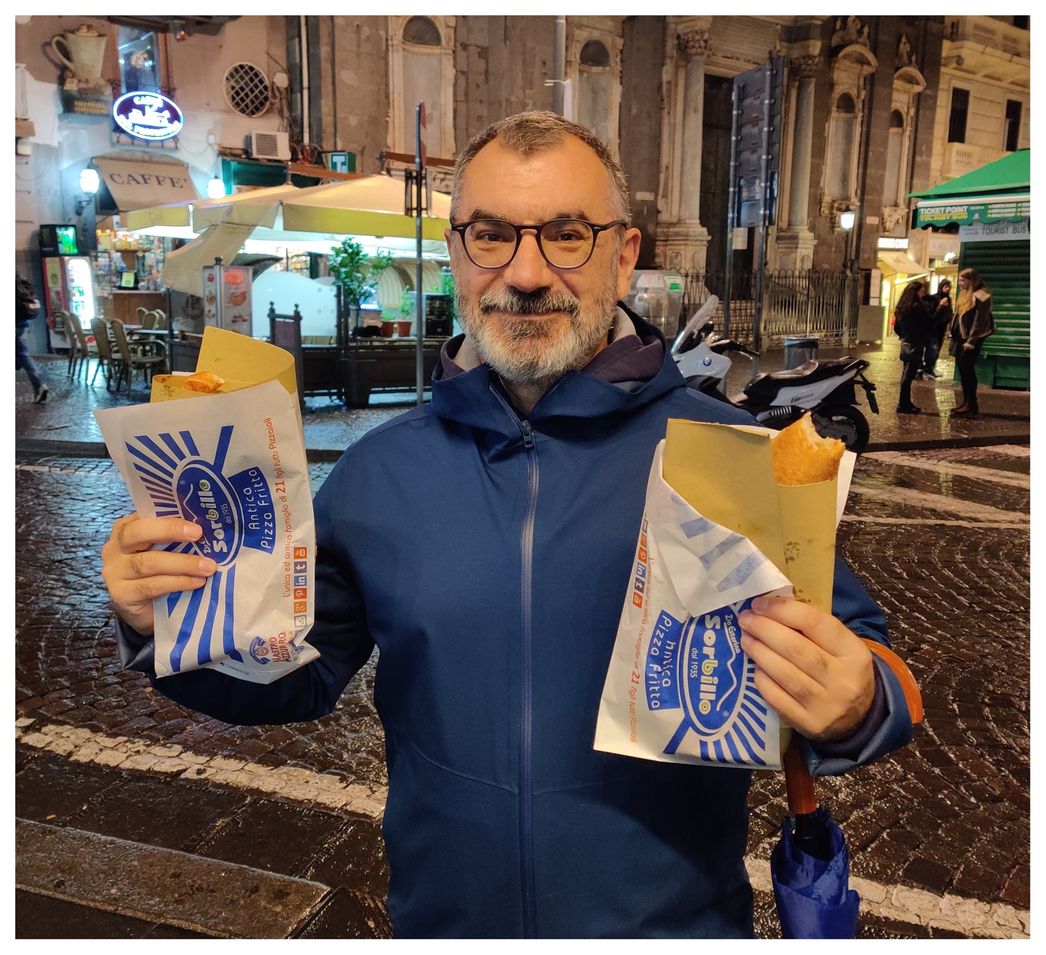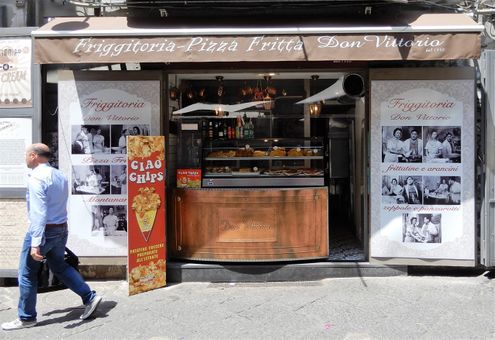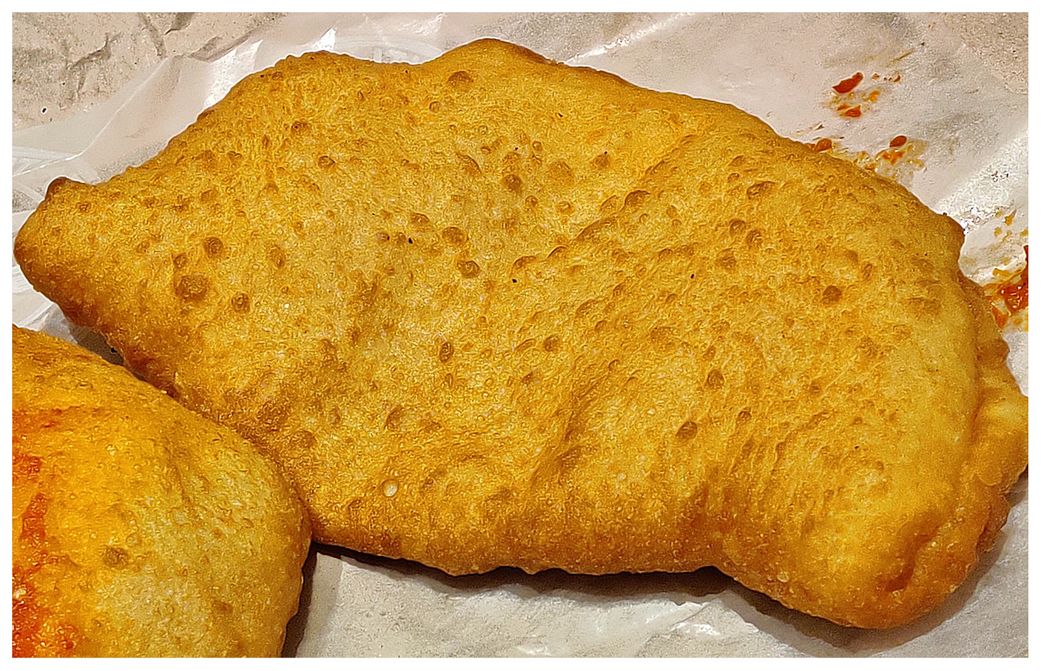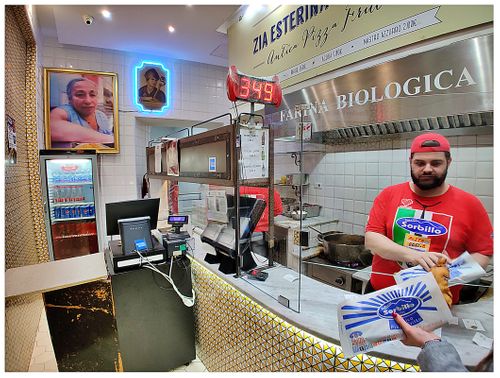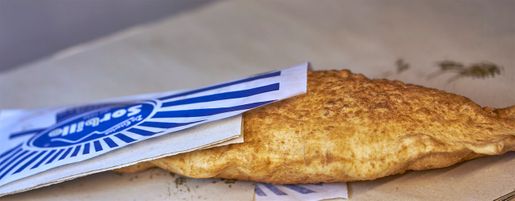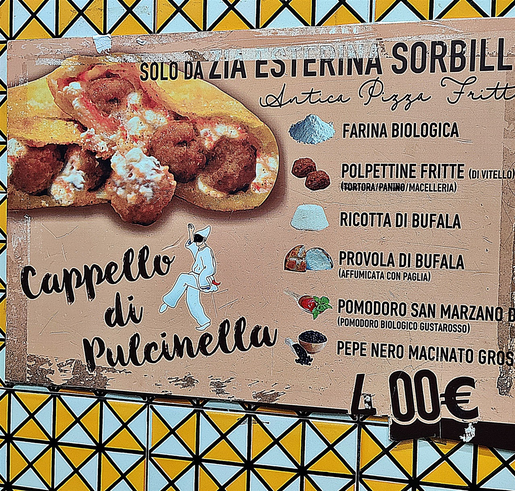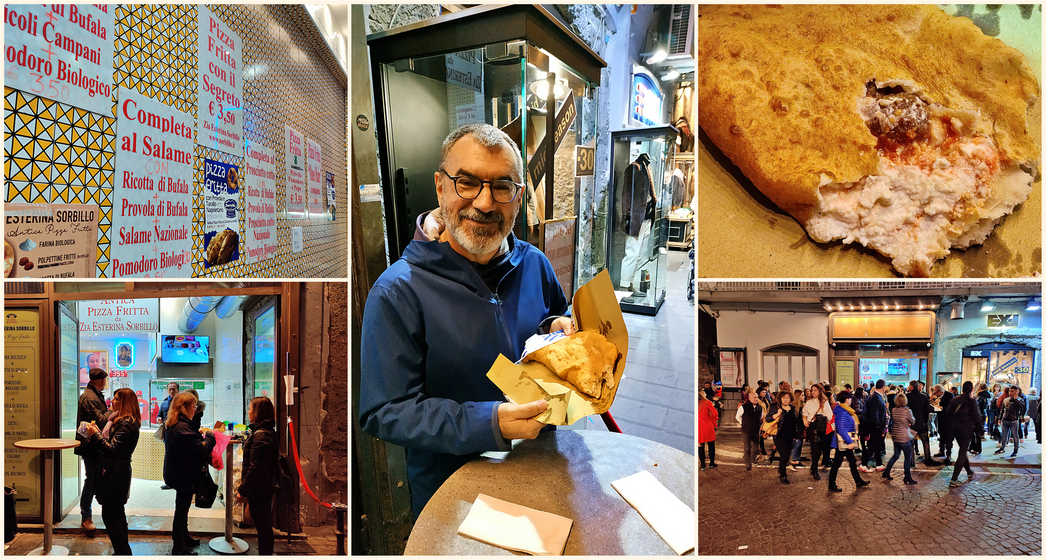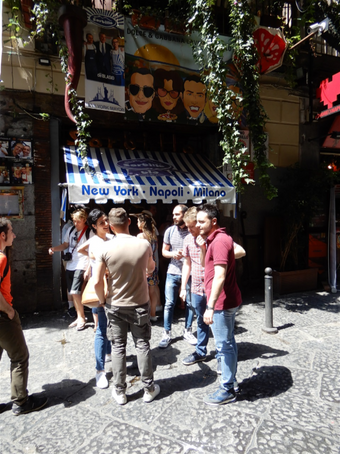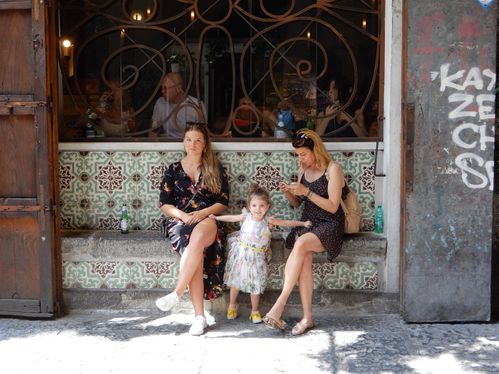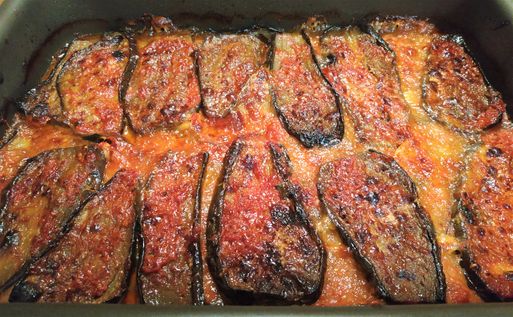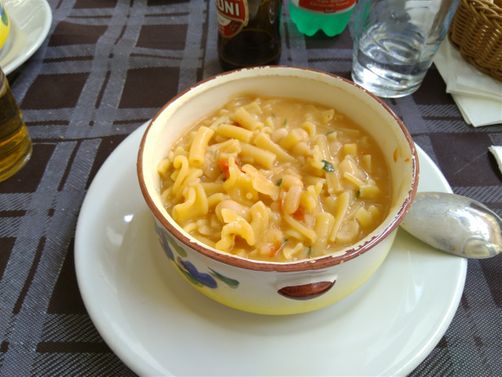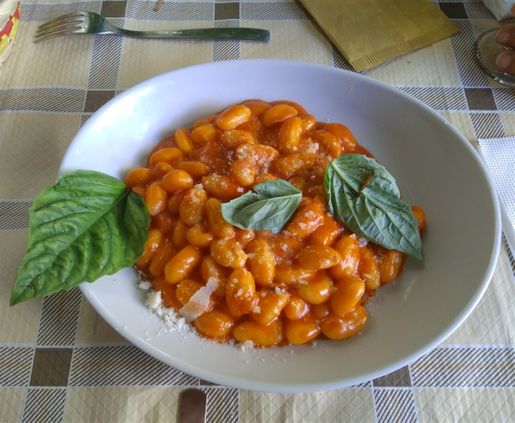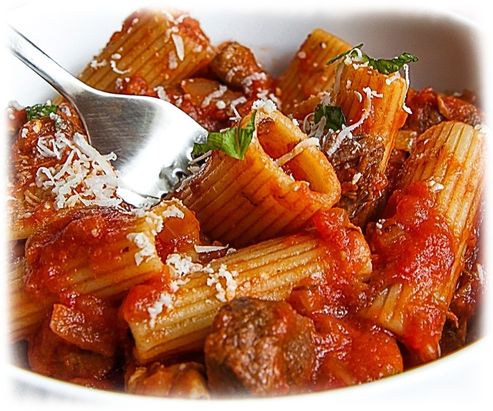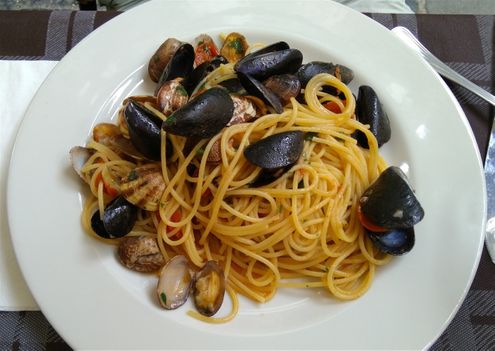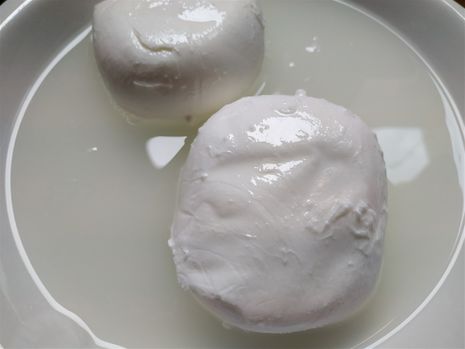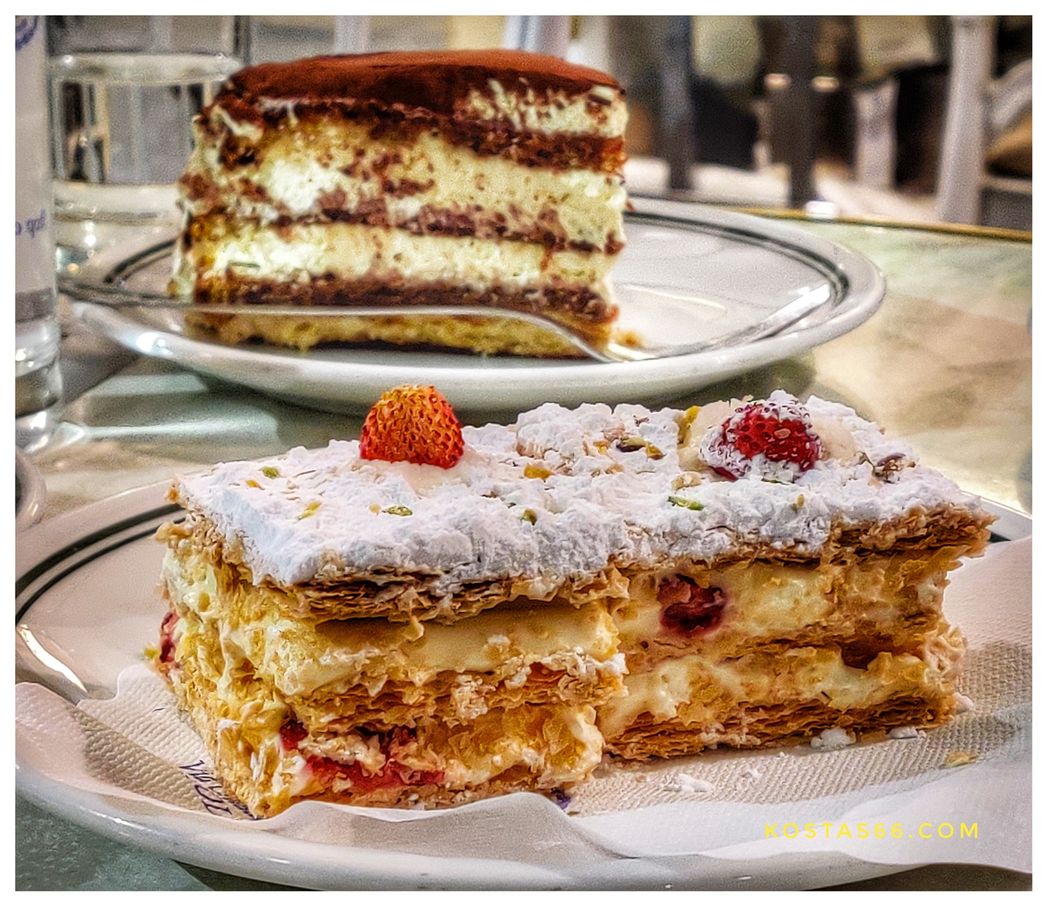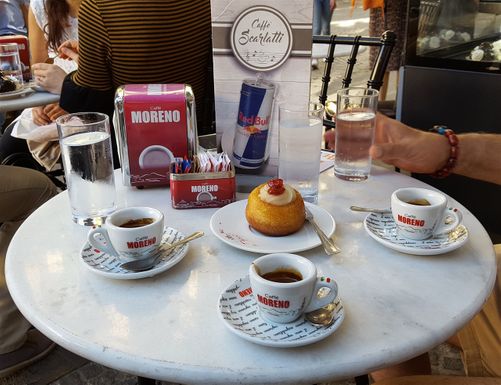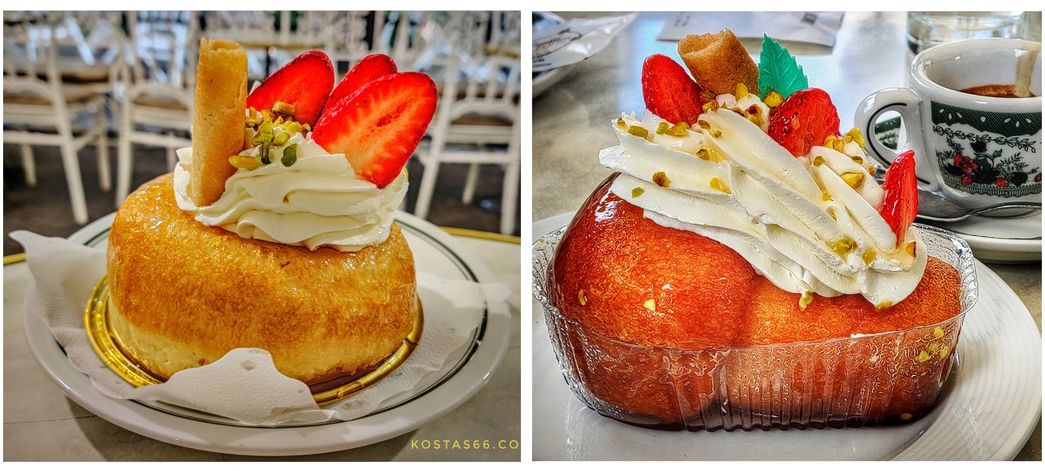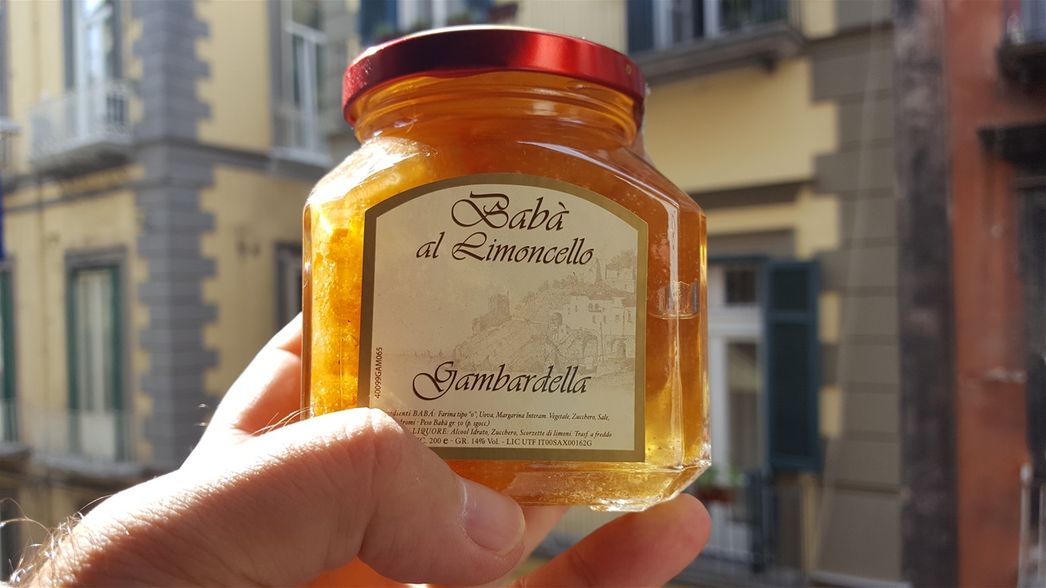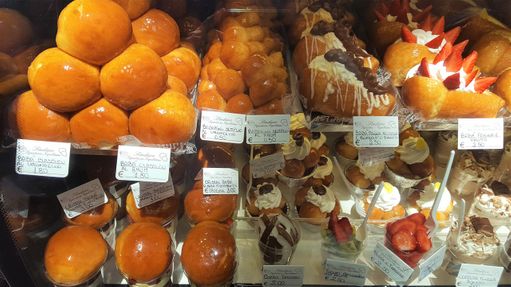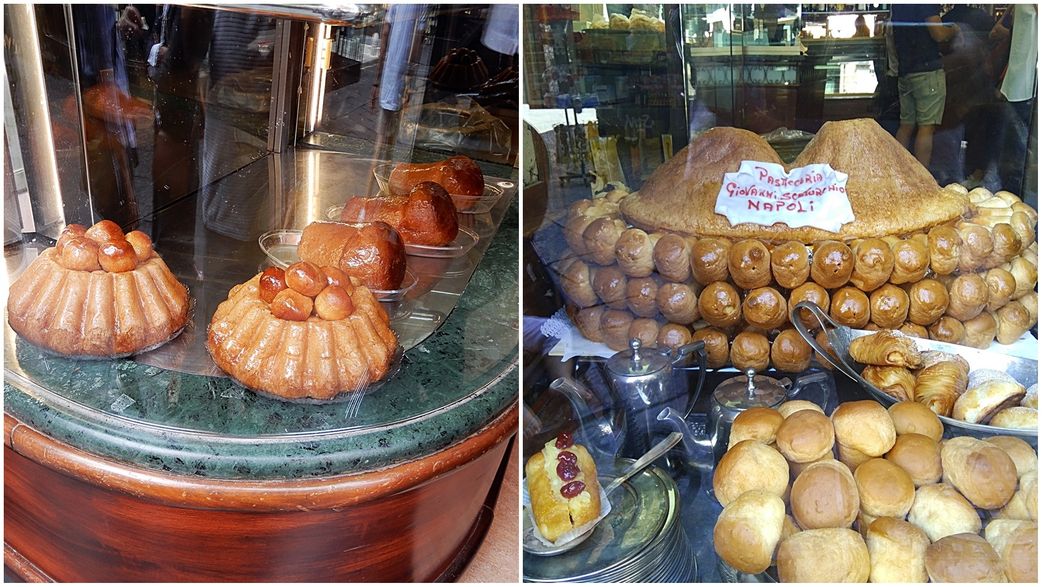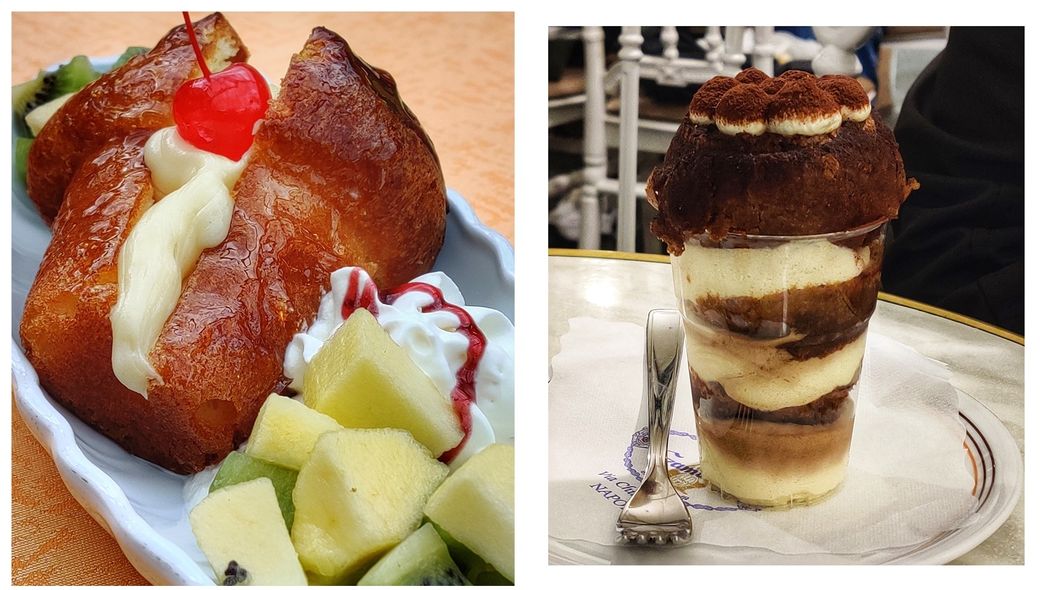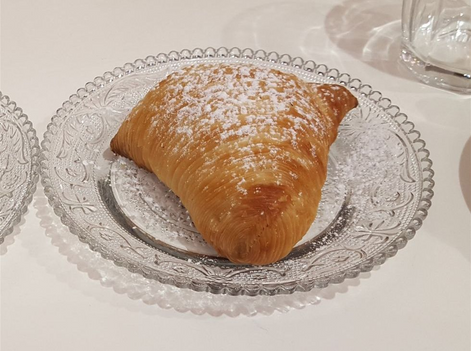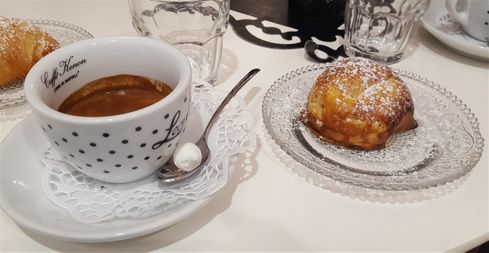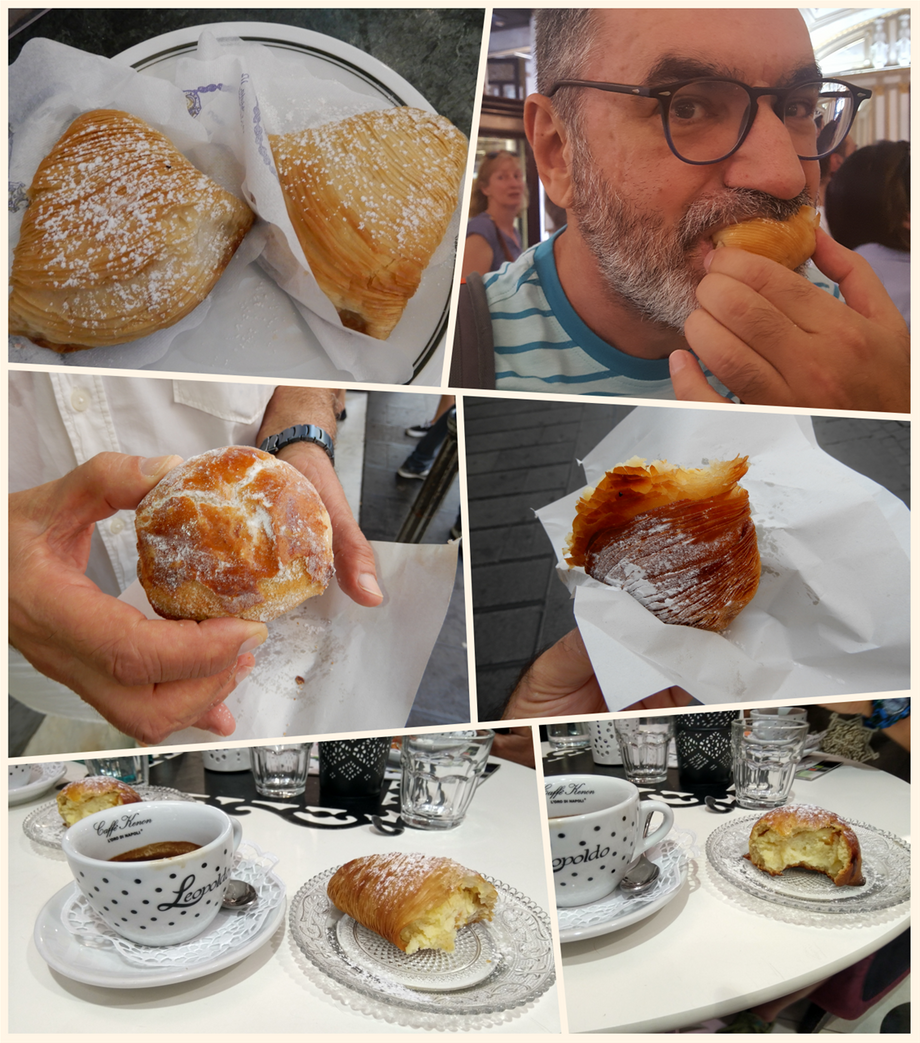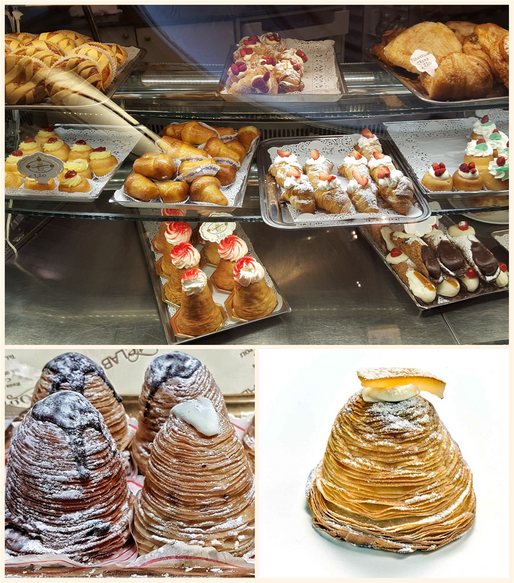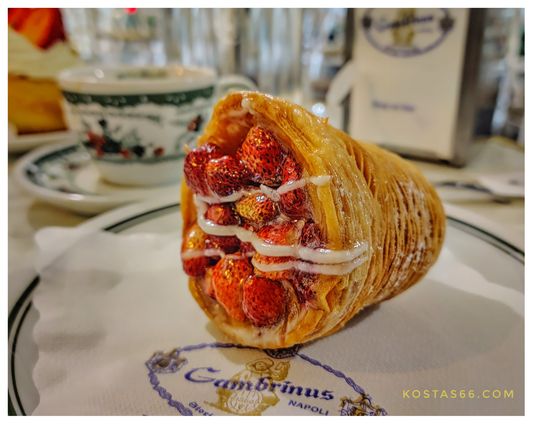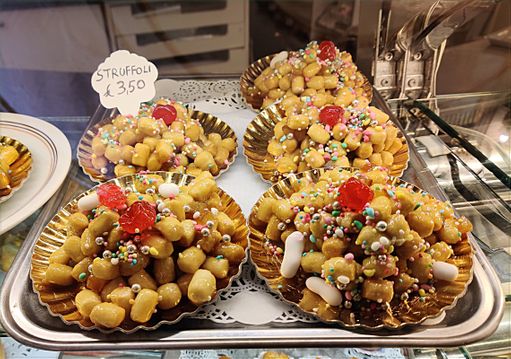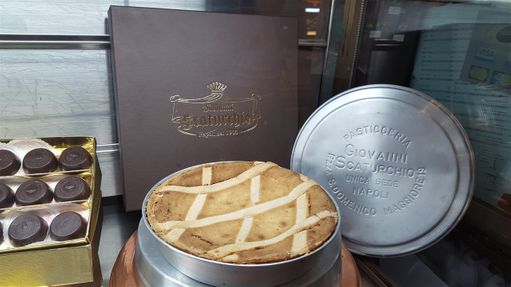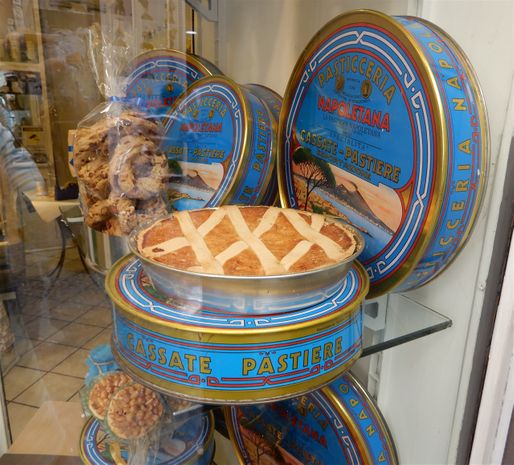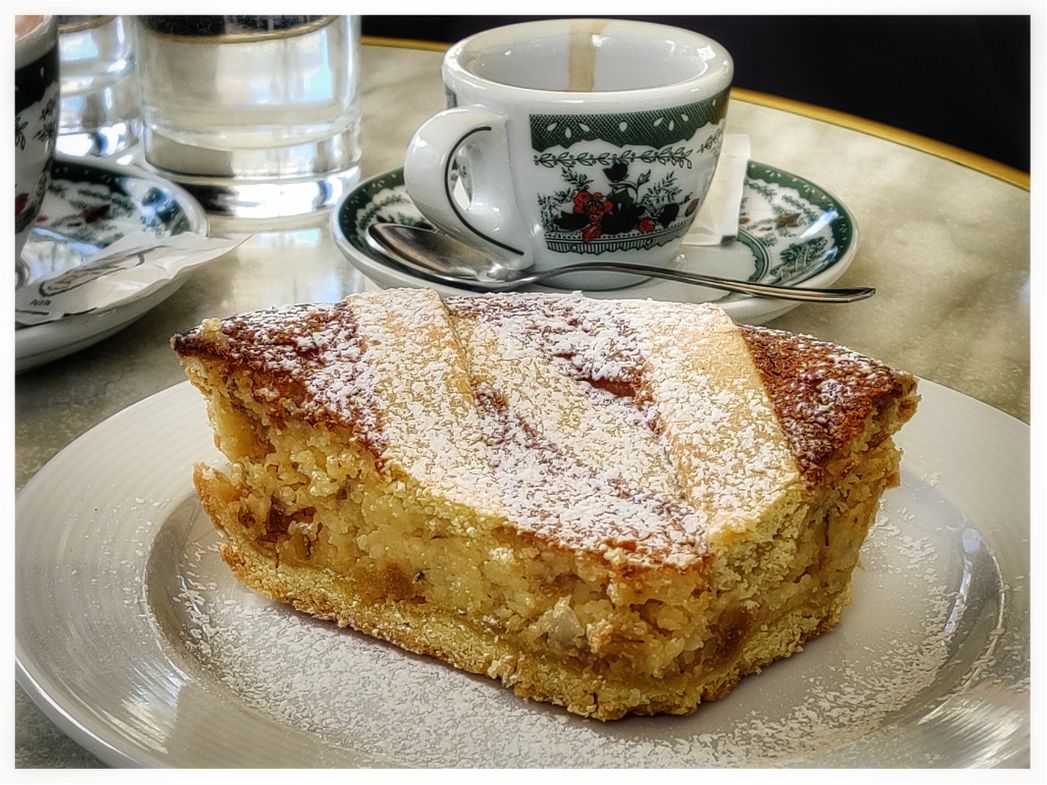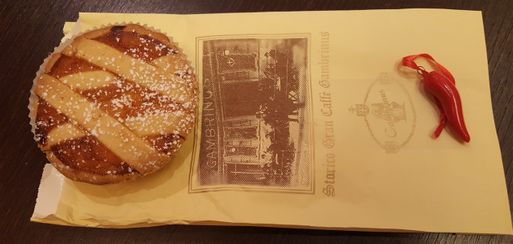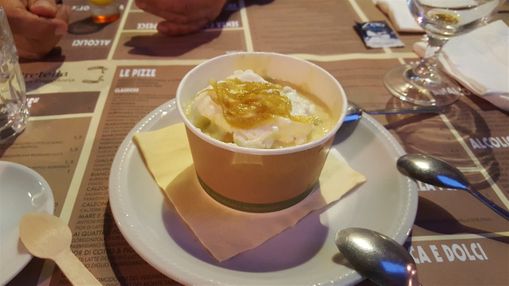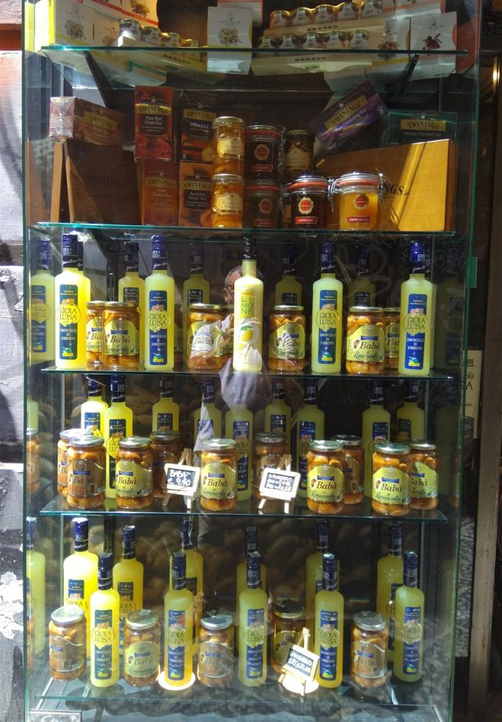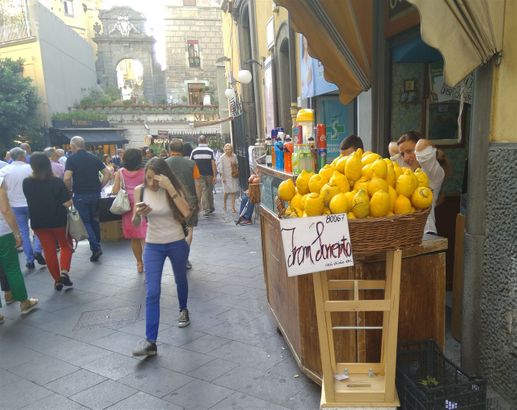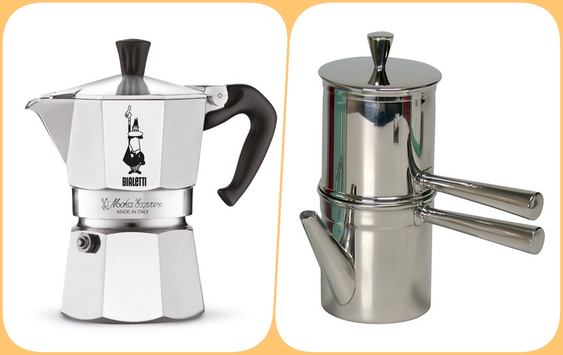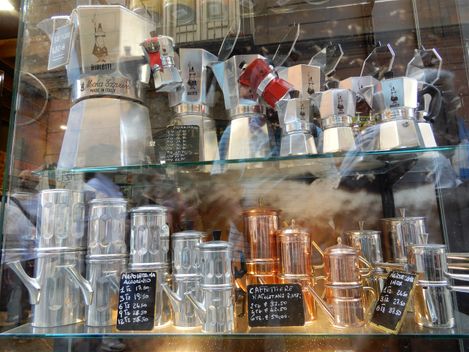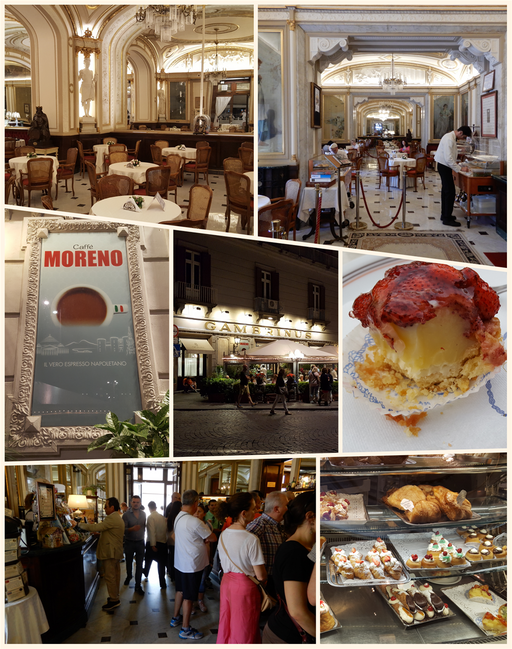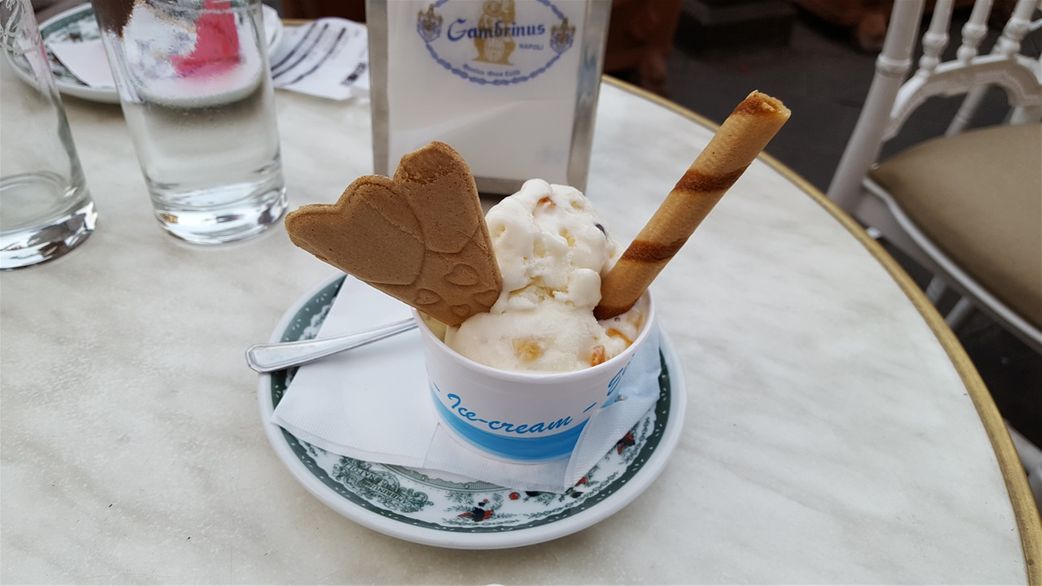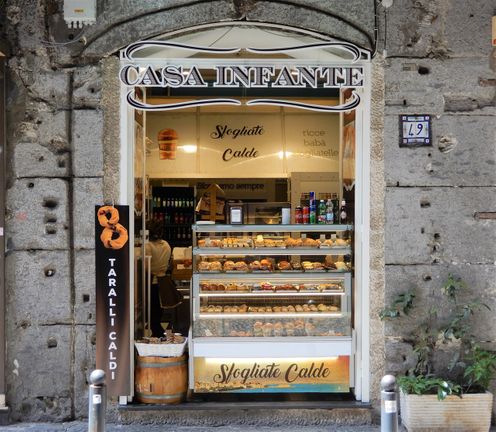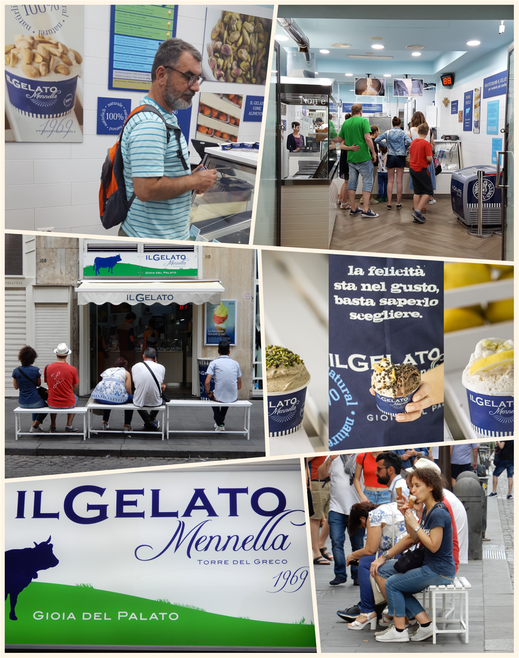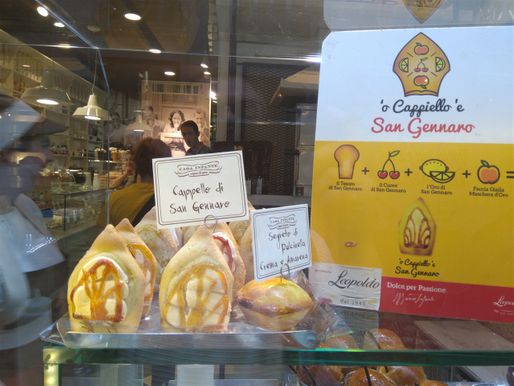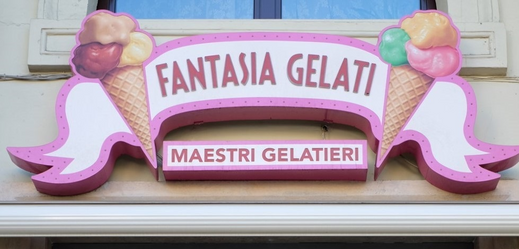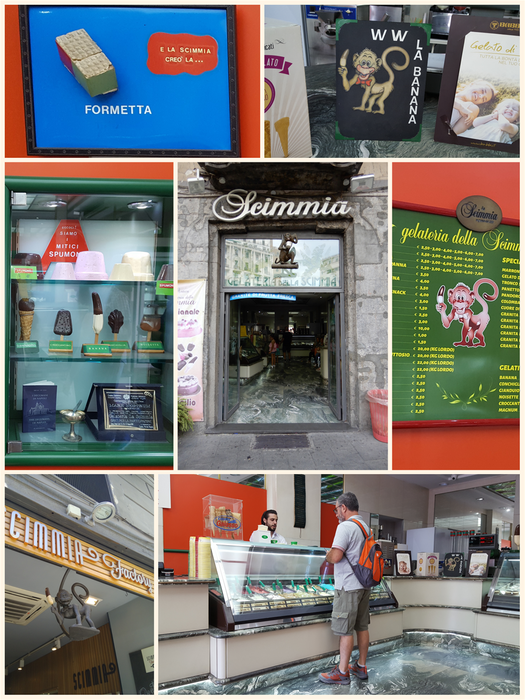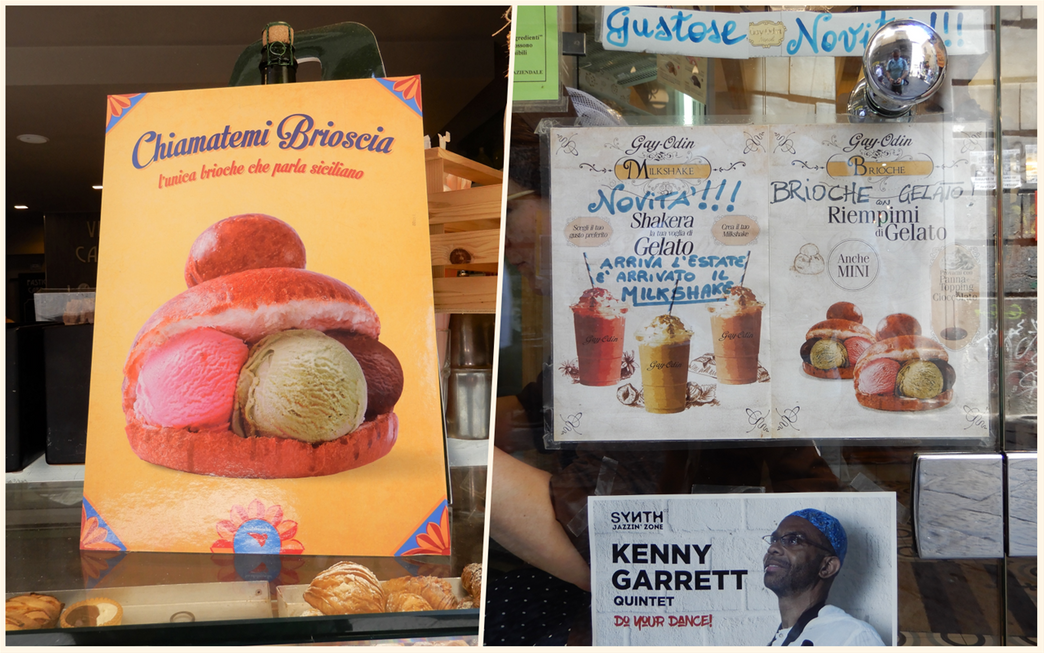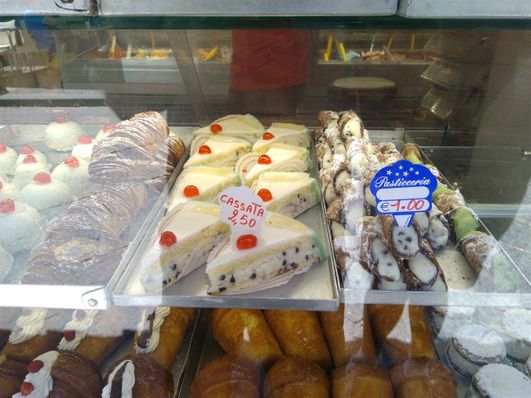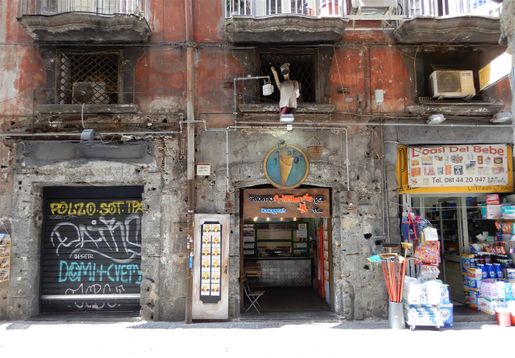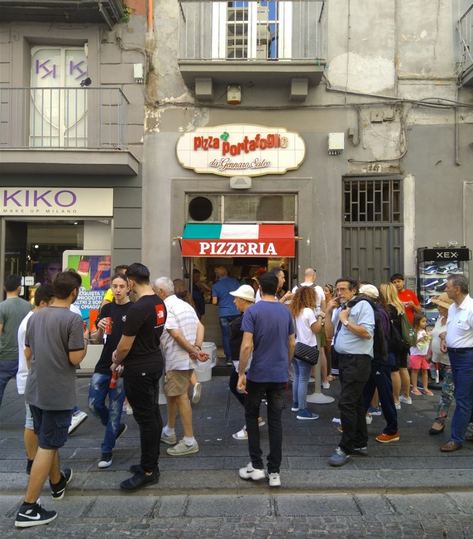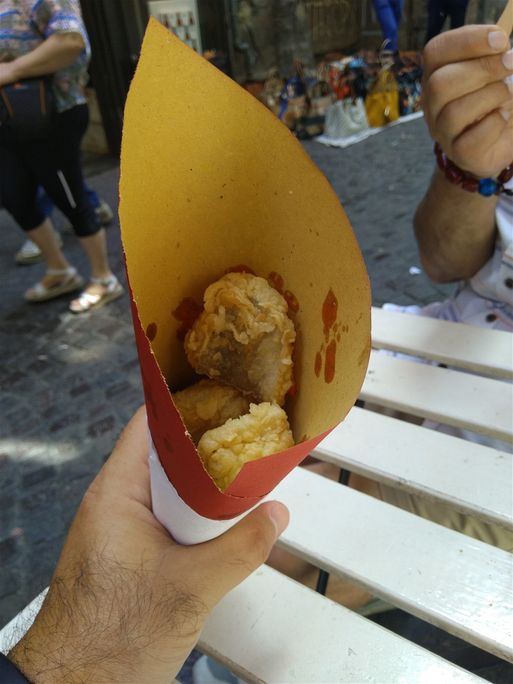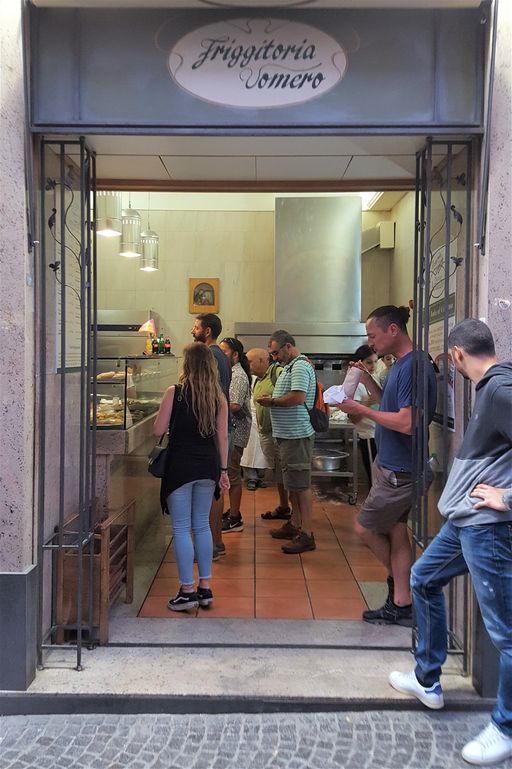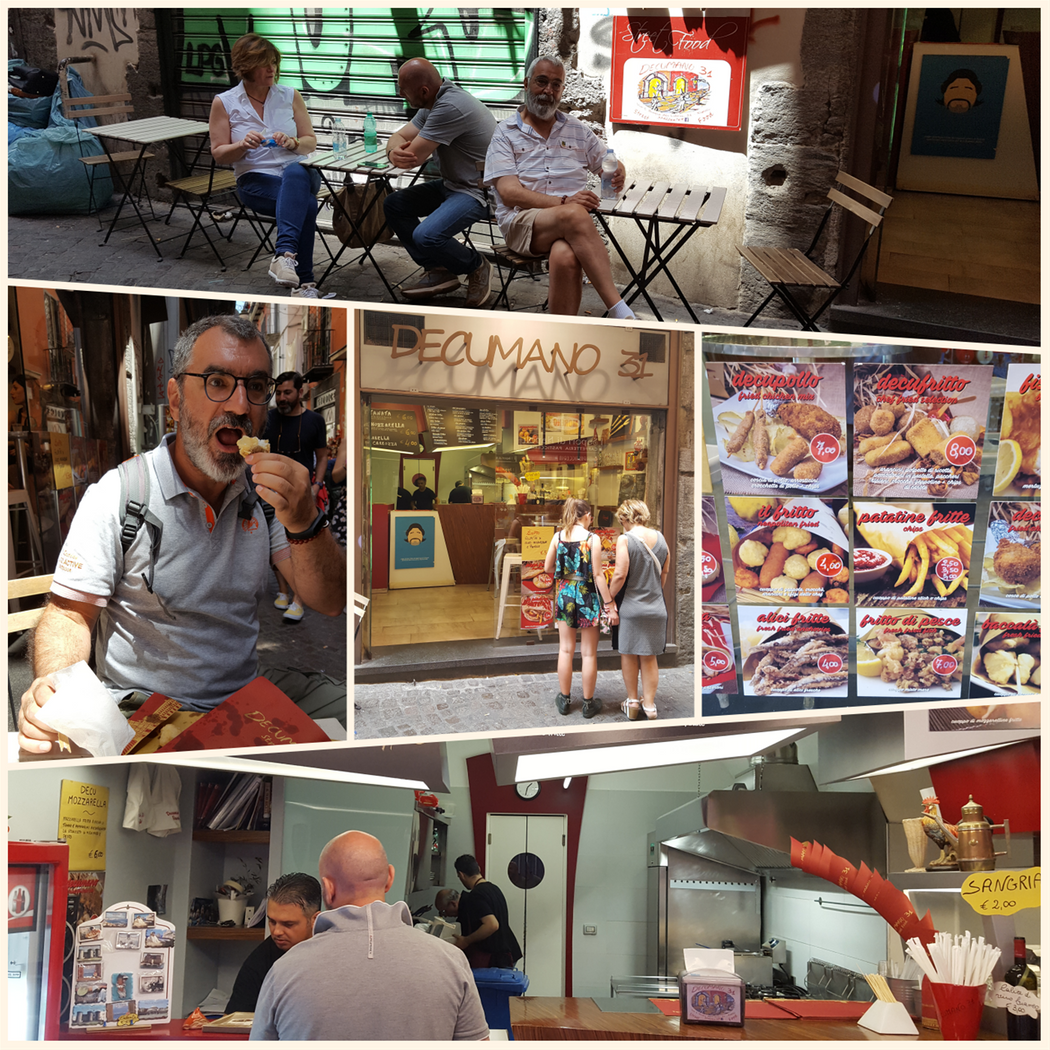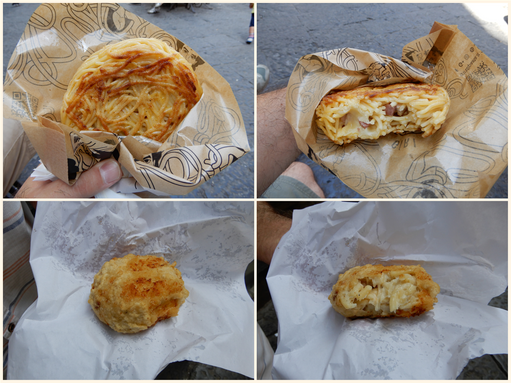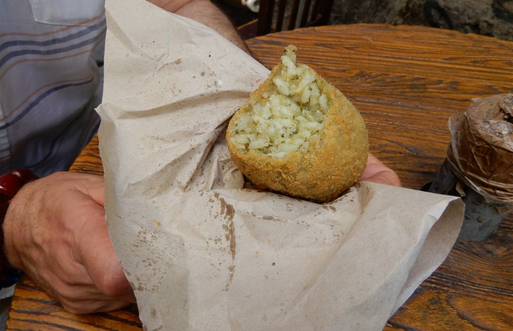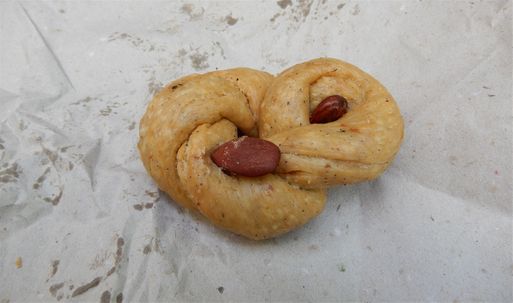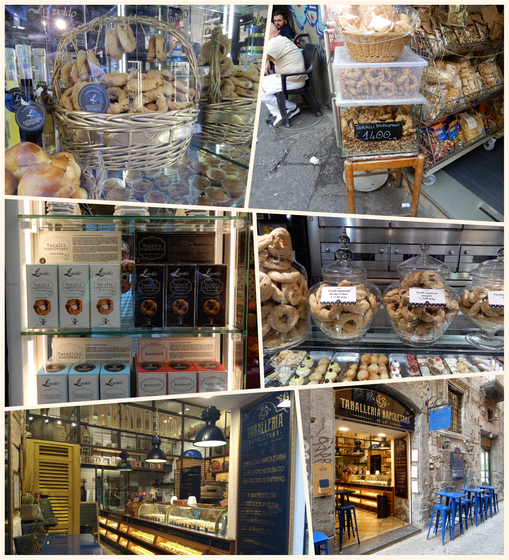NAPOLI
Part II: A Food Paradise
Street food is the essence of Neapolitan lifestyle.
This chapter (PART 2) of my Napoli trip deals with my favorite topic of discussion: food.
It's all about food
The cuisine of Napoli has a variety of dishes for any food lover, with flavors from the sea and ingredients enhanced from the sun and soil. There’s something for every taste; seafood, slow-cooked, succulent, sweet, simple, fussed-over, fried, pasta and of course pizza for the pizza lovers. The list is so long that makes it meaningless to try to name all in it, and certainly it is meaningless to try to eat everything while you are there. My advice: just pop into a restaurant/pizzeria/cafe that looks cozy to you, look around and order anything that you feel like eating at that very moment. No calculations, no hesitations. Try to include some traditional "trattoria" into your schedule and do not get lured only by the touristic establishments.
You may end up having the same dish again and again because you came across your favorite dish. This is great, too.
Pasta is one of the two staple italian foods, the other is pizza. Gnocchi "alla sorrentina" and spaghetti carbonara.
Do not stick to the “Italian dinner ritual”: antipasti, primi, secondi, dolce… This is bullshit. In Napoli a primo (first dish), which is mainly pasta, is big enough and fulfilling that may well play the role of the main and the only dish you order. Even if you are a voracious and greedy person (when it comes to food) like me, do not forget that later, in the course of the day, you may see something in another place you want also to eat…so, leave some space in your stomach.
Food can be inexpensive in Napoli, but restaurants are not cheap, unless you stick to pizza, which is the cheapest dish on every menu. Antipasti are unreasonably expensive compared to the rest of the menu items.
Moreover, do not forget Napoli is a street food paradise and for a couple of euros you can eat anything you want.
In Napoli a primo, which is mainly pasta, is big enough and fulfilling that may well play the role of the main and the only dish you order.
Having dinner at a traditional restaurant in "Quartieri Spagnoli" in central Napoli.
Food can be inexpensive in Napoli, but restaurants are not cheap, unless you stick to pizza, which is the cheapest dish on every menu. Antipasti are unreasonably expensive compared to the rest of the menu items.
But, do not forget Napoli is a street food paradise and for a couple of euros you can eat anything you want.
Pizza
Pizza is certainly the queen of Neapolitan food. Sometimes I wonder if there is a single person on this planet who does not like pizza. Pizzerias are everywhere, in every single country, and they are very popular. On this matter, we should thank American-Italians, since the worldwide pizza craziness originates in America and from there spread over the planet, long before us the lucky ones visit Italy. You know where you can have the best pizza in New York, in London, in Tokyo, in your home town; but trust me, you have want to taste the real thing you mut visit Napoli!
Pizza at 'L' Antica Pizzeria da Michele' in Via Cesare Sersale.
Before coming to Napoli, I read every single article about where to find the best pizza in the city. During the first days of my holidays there, I was trying to find the pizzeria I had saved in my “favorite list” on Google maps. Then I realized, that there was not a single place, where the pizza was not good.
Of course, there are the usual suspects: the tourist traps. The place where they sell the first ever baked pizza, the place where Bill Clinton slurped a “marinara”, the place where Julia Roberts decided to put some extra kilos, the place with the “I-do-not-know-what-marketing-has invented-this-time” pizza, etc, etc. Do not take me wrong. These places also serve excellent pizzas, but why should I wait in long lines to get squeezed in small rooms and eat my pizza while having the guy behind me rubbing his back on my back, when I can have a marvelous pizza in a humble but cozy pizzeria in one of the narrow alleys in Quartieri Spagnoli (Spanish Quarters)?
Pizza marinara.
Pizza Margherita
Pizza is the most popular and best-known creation of all Neapolitan cuisine. It is very popular among the "commons" as well as among barons and princes. Pizza already was present in the Bourbon court. King Ferdinand I experienced pizza baked in Capodimonte's porcelain ovens.
After Italian unification, the new kings were also attracted by this southern food. The pizzaiolo Raffaele Esposito created in 1889, in honor to queen Margherita of Savoy, a “nationalistic pizza”, where the colors of the Italian flag were represented by the mozzarella (white), tomato (red) and basil (green). Since then this pizza is known as “pizza Margherita”.
'Pizza Margherita DOP', made with tomato, buffalo mozzarella from Campania, basil and extra virgin olive oil. 'Pizzeria Dal Presidente' in Via dei Tribunali.
Pizza can be cheap and nutritious, so it gained great success very fast. Sometimes pizza is made in home ovens, but the real pizza must be cooked in a wood-fired oven, hand-made by an able pizzaiolo who makes the dough disk thinner in the center and thicker in the outer part; the ingredients and olive oil are rapidly spread on the disk, and with a quick movement the pizza is put on the shovel and then slid in the oven where it is turned around a few times for uniform cooking.
Extra virgin olive oil on top of it after coming out of the oven makes a lot of difference and sometimes a sprinkle of Parmesan Cheese on top give the final “finish”. This style pizza gave rise to the New York-style pizza that was first made by Italian immigrants to the US in the early 20th century.
Other variants are: pizza marinara, which is made with tomato, garlic, oregano and extra virgin olive oil and pizza Margherita DOP made with DOP products: tomato, buffalo mozzarella from Campania, basil and extra virgin olive oil.
Pizza Napoletana
Pizza marinara at "Crazy Bull" in Via dei Tribunali.
Pizza Margherita is called “Pizza Napolitana” if the tomatoes used are San Marzano tomatoes, which grow on the volcanic plains to the south of Mount Vesuvius, and the mozzarella used is Mozzarella di Bufala Campana, a protected designation of origin cheese made with the milk from water buffalo raised in the marshlands of Campania and Lazio in a semi-wild state.
Pizza Napolitana is a Traditional Speciality Guaranteed (TSG) product in Europe, the art of its making is included on UNESCO's list of intangible cultural heritage. The TSG certification attests that a particular food product objectively possesses specific characteristics which differentiate it from all others in its category, and that its raw materials, composition or method of production have been consistent for a minimum of 30 years.
According to the rules proposed by the Associazione Verace Pizza Napoletana, the genuine Neapolitan pizza dough consists of wheat flour (type 0 or 00, or a mixture of both), natural Neapolitan yeast or brewer's yeast, salt and water. For proper results, strong flour with high protein content (as used for bread-making rather than cakes) must be used. The dough must be kneaded by hand or with a low-speed mixer. After the rising process, the dough must be formed by hand without the help of a rolling pin or other machine and may be no more than 3 millimeters (0.12 in) thick. The pizza must be baked for 60–90 seconds in a 485 °C (905 °F) stone oven with an oak-wood fire. When cooked, it should be soft, elastic, tender and fragrant. WOW! No surprise, very few pizzerias serve pizza napolitana!
Where to eat Pizza
One of the best pizzerias I visited in Napoli, is Pizzeria 'Ntretella in Quartieri Spagnoli (Vico Maddalenella degli Spagnoli, 19). The premises that host the "Pizzeria Friggitoria 'Ntretella” date back to the early twentieth century and housed a sawmill that worked wood with machinery and produced wooden artifacts. The old lamps, the original space configuration, walls made of tuff stone, all have been fully respected to leave unchanged the romantic atmosphere of the past. (www.pizzeriantretella.it)
Pizzeria 'Ntretella offers not only pizza but also other traditional Neapolitan dishes by using genuine ingredients of strictly controlled origin and seasonal vegetables grown by farmers in the hills of the Parco Regionale del Taburno, at Sant’Agata de’ Goti. If you go early (before 7 in the evening) for dinner you may be lucky and get one of the few tables located outside on a wooden platform (whe the weather is warm enough of course). As the night falls, let the magic of Napoli seize your senses.
Pizzeria 'Ntretella.
Besides 'pizza al porcino' and 'pizza marinara', at 'Ntretella we ordered some 'fritti di mare' (baccala fresco a trancetti) and 'fritti di terra' (chrocce di patate, arancino, fiori di zucca in pastella). We finished the wonderful dinner with 'delizia al limone di Amalfi', a dessert made of the famous Amalfi lemons, and coffee.
"Pizzeria Friggitoria 'Ntretella”, should not be confused with "Locanda ‘Ntretella", a couple of blocks away in Salita San Anna di Palazzo.
Our order at pizzeria 'Ntretella.
Nevertheless, I think the best pizza I had was at a pizzeria which does not really look like a place you would expect much. 'Pizzeria D'Angeli' is a restaurant, that looks more like a fast food than a traditional Italian restaurant. It is a very modern, bright colored place with floor-to-ceiling windows. We got the best marinara pizza ever and a delicious salami pizza.(www.pizzeriadangeli.it/ )
'Pizzeria D'Angeli'.
We got in 'Pizzeria D'Angeli' accidentally, and the story goes like this: we decided to visit the famous 'L' Antica Pizzeria da Michele' in Via Cesare Sersale. This restaurant, which has been in the same location since 1930 and is run by a family whose pizza heritage goes back to 1870, is supposed to be known for making the best pizza in Napoli and is a point of pilgrimage for pizza lovers around the world.
The pizzeria of course has always been a famous pizzeria in Napoli, but since it was featured in the bestselling travel memoir 'Eat Pray Love' by Elizabeth Gilbert it turned in one of those tourist traps. “I love my pizza so much,” author Elizabeth Gilbert wrote on her visit to the restaurant, where she ordered a margherita with double mozzarella, “that I have come to believe in my delirium that my pizza might actually love me, in return. I am having a relationship with this pizza, almost an affair.” The pizzeria also featured in the film based on the book, in which Elizabeth Gilbert, played by Julia Roberts, can be seen mumbling the same lines in between bites of the classic Neapolitan dish. After the huge publicity it received, the 'Pizzeria da Michele' opened branches in London, Barcelona, Roma, Firenze, Milano, Fukuoka and Tokyo… and soon it will arrive in your neighborhood! It is business after all! (www.micheleintheworld.com/)
When we arrived, even though it was late afternoon, at a time people usually do not have lunch, there was a line of people coming out of the front door. I pushed people so I can have a look inside. I saw a very crowded place with tables in contact to each other, people trying hard to eat their pizza without having to throw the tomato sauce all over the unknown person sitting next to them! Well Julia, you can have your pizza here anytime you want… but not me, thank you.
We were really hungry. We looked around and show pizzeria D'Angeli. And what a surprise: the most delicious pizza we had all that week in Napoli.
Thank you Michele, thank you Elizabeth, thank you Julia.
L' Antica Pizzeria da Michele.
November 2019 update:
It was late in the evening (a very wet and rainy evening), while coming back on foot from the port and heading towards Via Chiaia, we passed very close by 'L' Antica Pizzeria da Michele'. I told my fellow travelers "let me show you the most famous pizzeria in Napoli". We went there and "miracolo"!!! The place was almost empty of tourists and there were just some local people devouring big pieces of pizza. Ok, that was our opportunity. We sat at a long table next to other people and we ordered the only two kinds of pizza the restaurant serves: margherita and marinara. I do not call off what I wrote above about the tourist traps, but yes...the pizza here is DELICIOUS!👍🤩👍 Fast service, very humble interior, very tasty pizza (alas the base was a bit burnt) and cheap prices.
Me at 'L' Antica Pizzeria da Michele'.
'L' Antica Pizzeria da Michele' serves only two kinds of pizza: marinara (left) and margherita (right).
As I said earlier, I am sure there is not a place in Napoli where they do not serve good pizza. Here are some more famous pizzerias you may want to visit:
'50 Kalò', Ciro Salvo’s restaurant, located in the Chiaia region (close to Mergellina e porto di Sannazaro), is one of the most famous pizzerias in Napoli.
'Pizzeria Brandi', located just off famous Via Chiaia, is where supposed pizza Margherita to be “invented”!
'Pizzeria Tutino dal 1935', located just opposite Circumvesuviana train station, in the fish market of Porta Nolana. This is a very old restaurant, which has recently gone thru a thorough facelift to meet modern standards.
'Pizzeria Sandropizzettata' is located in Via Francesco Solimena at the upscale neighborhood of Vomero.
'Pizzeria Da Attilio', located close to Piazza Carita, in the very picturesque and must visit neighborhood of Montesanto.
'Pizzeria Dal Presidente' is located in Via dei Tribunali, at the heart of the medieval part of the city, which is a must for the tourists street. Take one of the tables on Piazza Gerolomini and enjoy the pictures of the famous who had pizza here. You can see them depicted on the paper sous-plats.
Pizzeria Dal Presidente.
‘Napoli Pizza Village’ festival
Neapolitans value pizza so much that they have a special festival taking place every year dedicated to the pizza culture. The popular festival ‘Napoli Pizza Village’ is an ambitious project that grows year after year and aspires to globally promote one of the symbols par excellence of Italianism all over the world: pizza. This year, from 1 to 10 June 2018, they organized the eighth festival, which took place at Lungomare Caracciolo.
8th Napoli Pizza Village.
For 10 days, in an imposing village of 30,000 square meters, 50 renowned pizzerias and hundreds of prominent figures of the pizza world met the fans in a big party, with many live events and concerts, exhibitions, conferences and entertainment & educational workshops for adults and children.
Pizza fritta
One of the 50 pizzaioli baking pizza in real wood-fired oven, in 8th Napoli PIzza Village.
Pizza fritta (or deep-fried pizza) is a dish consisting of a pizza that instead of being baked in an oven is deep-fried, resulting in a different flavor and nutritional profile. Originated in Napoli, pizza fritta is usually made by frying a disk of pizza dough before applying toppings and serving. Alternatively, the fillings may be enclosed in a pocket of dough like a calzone. Frying allows one to prepare a pizza without a pizza oven, for example from a street food cart where an oven is impractical.
Pizza fritta is served in many pizzerias, but it is mainly a cheap and tasty street food.
One pizza fritta is never enough!
Pizza fritta has one of the leading roles in Vittorio De Sica’s 1954 movie, ‘L’ Oro di Napoli’. In episode No 2 (of a total of 6 episodes) called ‘pizzas on credit’ (‘pizze a credito’), Donna Sofia (played by Sofia Loren) works with her husband Rosario in a very small ‘friggitoria’. The story goes like this: she is so beautiful that every man secretly loves her and this makes Rosario very jealous. One day, the accidental loss of her precious engagement ring gives way to a series of paradox situations, since it’s possible that the jewel has fallen in the dough of one of the pizzas already sold.
From film 'L' oro di Napoli'. Episode 2: ‘pizze a credito’.
In the film, stunning Loren shows some skills flouring and stretching dough into modest discs and dropping them in a cauldron of hot oil. This particular scene goes on for three or four minutes. Eventually, the camera pans to a young, good-looking Italian sitting on a street cart. He is eating pizza and smiling like a love-struck fool. Loren blushes, runs her fingers across her chest, touches her hair, smiles back. But here’s what Loren and the viewers and anybody who hasn’t eat pizza fritta don’t know: He wasn’t smiling at the goddess before him; he was smiling at the golden discs of pleasure she was peddling.
At the restaurant ‘pizze fritte - friggitoria don vittorio’ located at Piazzetta Nilo, one can see pictures of Sofia Loren as Donna Sofia in De Sica’s film.
At the restaurant ‘pizze fritte - friggitoria don vittorio’ located at Piazzetta Nilo, one can see pictures of Sofia Loren as Donna Sofia in De Sica’s film.
There are many different types of fried pizza in Napoli, but the following four are the most known:
‘Zeppola’, also known as ‘pasta cresciuta’, is the simplest type of fried pizza. It is quite small and is prepared by frying for a short time a little piece of dough, made with flour, water and yeast. The only seasoning is salt. Together with the ‘crocchè’, it is one of the most classic street foods in Napoli.
The classic fried pizza is just a larger version of a zeppola, and shares the same ingredients with it. Its dough is usually flattened by hand before frying. Once again, the only seasoning is salt.
Classic pizza fritta.
‘Montanara’ is much more elaborate than the classic fried pizza. The main differences are two: the first is that it’s flavored with tomato, provola cheese, parmesan and basil; and the second difference is the slightly different cooking procedure _once its dough is fried, its cooking continues in the oven.
‘Calzone fritto’. The stuffed fried pizza is also known as ‘calzone fritto’ (fried ‘calzone’). Its dough is flattened by hand, garnished and folded. This sort of ‘pouch’ is then fried and served. The most typical calzone fritto is filled with just ricotta cheese and flavored with black pepper, but of course, only imagination limits the ingredients one can put in there.
I had some of the best montanara at ‘Gennaro Salvo Pizza a Portafoglio’, at the beginning of the famous pedestrian street Via Toledo (Opposite Galleria Umberto I), just two blocks further north from the other famous pizza fritta take away shop, ‘Antica Pizza Fritta da Zia Esterina Sorbillo’.
Inside ‘Antica Pizza Fritta da Zia Esterina Sorbillo’. Pizaiolos here have some extra kilos...obviously they also enjoy their products!
One of the many night I had visited ‘Antica Pizza Fritta da Zia Esterina Sorbillo’, I decided to taste it's lattest success called "Capello di Pulcinella". This ‘Calzone fritto’, besides ricotta, provola, pomodoro san Marzano and pepe, is tuffed with Polpettine Fritte (fried meatballs)... a must try delicacy!
"Capello di Pulcinella" at Zia Esterina Sorbillo.
Classic pizza fritta from the famous take away shop, ‘Antica Pizza Fritta da Zia Esterina Sorbillo’.
Esterina's is a very small shop that serves only take away pizza fritta. Here there are always long lines of customers, but you should not be dissapointed: the lines move fast. To oder you enter the shop, check the menu whch is written on the wall on your left hand, proceed to the cash desk, you give the order, pay and get a ticket with a number written on it. Then you wait for your number to appear at an electronic bulletin board on the wall. When your number appears you approach the people that prepare your order ....and then I am sure you know what to do with your order.
‘Antica Pizza Fritta da Zia Esterina Sorbillo’.
Esterina is Gino Sorbillo’s beloved aunt. But, who is Gino?
Gino Sorbillo is considered Naples's best pizza maker. Gino's father was number nineteen of 21 siblings who were all pizza-makers, along with his parents. No surprise, Gino decided to become also a pizzaiolo.
Number 32 on Via dei Tribunali is home to 'La Pizzeria Sorbillo', maybe the most famous pizzeria in Napoli. Each pizza is named after one of Gino's siblings and various family members, from Ciro, one of his uncles, to Esterina, Gino's beloved aunt.
Pizza-master Gino Sorbillo has garnered a long list of awards and when he's not flipping dough, Gino is traveling around the world making appearances on cooking shows, explaining his ethos on perfecting pizza napolitana. To put it in other words, Gino is a celebrity.
Gino is somehow a hero for the pizzaioli as he is responsible for changing the perception of the pizzaiolo from a second-rate cook into a deeply-respected position and has managed to elevate pizza into a highly-respected cuisine.
The success of his restaurant and the number of people it attracts have been great catalysts for the neighborhood's rebirth.
Sorbillo has brought thousands of tourists to the neighborhood and employs many people. This renewed interest in the area has also prompted other shops to open along Via dei Tribunali to serve the growing influx. Today Via Tribunali is one of the most visited streets by tourists, as well as locals.
But, we are in Napoli and you have to play fair with the Camorra.
Gino’s restaurant was burned down by the Camorra some years ago. They say the reason is that Gino refused to pay the 'pizzo', the percentage that organized crime asks businesses operating in their area to pay to be protected. But, who knows what the truth is!
Number 32 on Via dei Tribunali is home to 'La Pizzeria Sorbillo'.
Outside 'La Pizzeria Sorbillo' in Via dei Tribunali.
I didn’t have pizza at Sorbillo's. As I explained earlier I am freaking out when I see people line up waiting for a table. I’d rather starve.
More than just pizza
Parmigiana di Melenzane I cooked at home when I came back from Napoli.
'Pasta E Fagioli'. This is the best dish of what we call ‘cucina povera’. Two items that can stretch a dish to feed more on less, beans and pasta, combine to make one of the most famous dishes of Napoli. The pasta with beans is delicious and very nutritious as well! There are other variations of this dish using chickpeas or lentils instead of beans. We refer as ‘cucina povera’, dishes originally cooked by the peasants who, with a few fresh, natural ingredients (produced by themselves), they could feed their families with something genuine and extremely good.
Cucina di Napoli is not only pizza. It is much more. You certainly cannot taste many dishes during a short visit in Napoli, but try at least these:
'Parmigiana Di Melenzane'. All the flavors of the region layered one upon the other; fried eggplant, tomato sauce, mozzarella, Parmesan and basil. The dish has spread throughout Italy and the world, but you should try it here where it started and where the ingredients have a deep flavor enhanced by the volcanic soil.
Pasta e Fagioli. We had this delicious dish off Via Santa Lucia next to Conad City Supermercato.
'Pasta e fagioli' is so famous that triggered the 1984 ‘Pasta e fagioli’ song by Lino Toffolo, which makes fun of the Germans on holiday using various stereotypes. It is a reinterpretation of the 1983 ‘Roman soup’ song by the German group ‘Schrott nach 8’, a parody of Italian culinary specialties.
‘Pasta Gragnano and Ragù'. This is a long cooked ragù (sauce) made with small pieces of meat and dried pasta from Gragnano, the town near Napoli famous for its dried pasta. This classic Neapolitan dish is the most known condiment and much appreciated in Campania, but it is not eaten much in everyday life because of his long preparation. What makes this dish so tasty is the use of multiple types of meat: beef, pork, veal and chanterelles. The tomato is the other inevitable ingredient of this ancient Neapolitan recipe, which characterizes and makes recognizable Mediterranean dishes.
Gnocchi alla Sorrentina I had at Vomero.
‘Cozze’. Mussels is a must when visiting Napoli. Try them ‘alla marinara’, cooked in a tomato sauce spiced up a bit with peperoncini and parsley and served on toasted bread to absorb all the juices. Impepata di Cozze (mussels cooked in their own juices with black pepper) is also another good choice.
‘Polpette’. Meatballs are a Neapolitan specialty, but unfortunately, they are not served on top of spaghetti, which is my favorite dish. They are served as a secondo (main course) in tomato sauce.
Pasta Gragnano and Ragù.
'Gnocchi alla Sorrentina'. A much-loved dish in all over of Italy. Gnocchi made in the Sorrento style, are fluffy potato “knuckles” that float in a sweet tomato sauce and surrounded by melted mozzarella. A divine use of potatoes and cheese! I loved this dish so much, that when I came back to Athens I cooked it as soon as possible. I got some really nice mozzarella and some biological tomato juice and I used honey as sweetener... you see I like to improvise. You can read my recipe here:
Cozze spaghetti.
‘Mozzarella di Bufala’. This is not a dish per se, but fresh, tasty and appetizing, there is nothing like the Mozzarella di Bufala Campana PDO. A soft cheese, typical from the Campania region, where the buffalos are raised in a natural way. Its delicious taste is closely linked to the history and culinary traditions of Southern Italy. Its taste will bring in your mind bucolic images.
i DOLCI
Food is not only savory, but also ‘dolce’ (sweet). Napoli has some iconic dolci one can taste both at a café/pasticceria but also as a street food.
Dolci at Gran Caffè Gambrinus: tiramisu & mille foglie.
Babà, is the most prominent dessert is Napoli. This phallus-shaped (officially it is mushroom-shaped) yeast cake, soaked in a syrup of liquor has taken Napoli.
Babà has its roots in Poland and named after Ali Baba. The classic version is served plain and soaked in a rum, strega, or limoncello-based syrup, but you can also find them sliced and filled with pastry cream, ricotta cream, whipped cream and fruit (mainly strawberries), lemon cream or Nutella. Nothing is more typical Neapolitan than the mythical and delicious "Babà" and you absolutely have to try it.
Baba and coffee at Cafe Scarlatti.
Baba with cream.
Fun fact: if you say to someone “si nu' babbà” (you are a baba), you’re complimenting this person in one of the sweetest ways possible.
Baba al Limoncello. A perfect souvenir.
In the late 18th century, Maria Carolina of Austria, the Queen of Napoli and wife of Ferdinand I, sent Neapolitan chefs to her sister Marie Antoinette in Paris to learn the techniques of French cooking. As a result, many dishes that today are considered fundamental to Neapolitan cuisine have their origins in France. Babà is one of these dishes, which in Napoli took its characteristic shape and brought to perfection: it is soft, light, perfectly moist with a light brownish crust on the outside and can satisfy the most discerning palate with its strong and intense taste.
The kingdom of Baba!
Giant Baba (left) and the 'Baba Vesuvio' at the window of Pasticceria Scaturchio. The Vesuvius Babà The story behind the Vesuvius Babà dates back to 1994, the year the G7 summit came to Naples. For the occasion, confectioner Giovanni Scaturchio created a babà in the shape of Mount Vesuvius, with the intention of showing the world leaders the fusion of Neapolitan creativity with the art of pastry-making. Our Vesuvius Babà was an enormous success and as such, the name, shape and idea were patented in 1995, meaning the Giovanni Scaturchio brand is the holder of the trademark and no other institution can reproduce a babà in the shape of Vesuvius for commercial purposes.
The latest years, a new version emerged that you can eat either at a cafe or on the go while window shopping in Via Toledo: layers of sliced baba and cream in a tall glass. Fruit or whatever else you desire give the final touch in this new madness that shows the creativity of the Neapolitan cuisine.
A special baba at Fauno Bar in Piazza Torquato Tasso, in Sorrento (left) baba-tiramisu at Gran Caffè Gambrinus in Napoli (right).
Sfogliatella. The only other dessert that can rival babà in popularity is Sfogliatella, which can be eaten at any time: breakfast, coffee after lunch and for a snack. In Neapolitan cuisine, there are two kinds of the pastry: "sfogliatella riccia" ("curly") which is a clam shaped pastry made of flaky dough and "sfogliatella frolla," a less labor-intensive pastry that uses a shortcrust dough and does not form the riccia’s characteristic layers (it has a smooth exterior).
Sfogliatella riccia.
In both types, the pastry is typically filled with a sweetened ricotta (more rarely almond) paste and candied citrus fruit and topped with powdered sugar. Between the flakes of pastry and the sugar, don’t plan on staying clean while you eat it. Sample, sample, and sample some more while you’re there. Every single café and pasticceria sells sfogliatelle.
Sfoliatella frolla.
Sfoliatelle!
Sfogliatella riccia is so popular, that from time to time pasticcerie in Napoli "invent" new variations of this beautiful creation and try to spoil us. Sfoglia Campanella and Matilda are two of these novelties.
Sfoglia Campanella. Because two sfogliatella versions weren’t enough, Vincenzo Ferrieri of Sfogliatelab pastry shop (at Piazza Garibaldi, opposite the Central Station) has invented recently a new variation on the theme that has immediately gone viral. This pastry is called “sfogliacampanella“, because it looks like a little bell, with the same crispy outside of the sfogliatella riccia. Yet this one is filled with a tiny babà, enveloped in creamy white or dark chocolate, and some ricotta cheese cream. It’s an explosion of flavors that you just won’t forget.
Today, many pasticcerie bake similar sfogliatelle.
Top picture: Sfoglia Campanella (middle bottom of the picture) among other famous "dolci". Bottom pictures: other variations of Sfoglia Campanelle.
Matilda. Sfogliatella, babà or strawberries tartlet? Why puzzling with this doubt in front of a window when it is simply possible to order a Matilda? The Matilda is one of the last creations of the Gran Caffè Gambrinus, which contains in a simple sweet, the three culinary excellence of the above mentioned bells. This dessert looks like a puff pastry cone typical of the classic Neapolitan ricotta sfogliatella, with a filling of babà inside, garnished with chantilly cream and wild strawberries. With only one choice and above all with only one bite, it is possible to taste three components of the best pastry made in Napoli.
The story of this dessert, in reality is nothing but a tribute to a great Italian writer and journalist who founded the morning newspaper 'Il Mattino', we are talking about Matilde Serao, a character whose story is closely linked to Gambrinus. There could not therefore be a more appropriate tribute than this, a small dessert for a great Italian woman.
Struffoli.
Pastiera, is a shortcrust pastry filled with eggs, ricotta cheese, boiled grains of wheat, custard, candied fruit, and aromatics (including orange flower water), topped with a lattice made from the same pastry. Like the Proustian madeleine, sweets can stir up all kinds of feelings in the minds of those who eat them. In Napoli, struffoli (small, round doughnuts glazed with honey) and cassata (sponge cake with ricotta and candied fruit) speak of Christmas, while chiacchiere (sugar-dusted fritters) and sanguinaccio (literally "blood pudding”, but actually made of chocolate) bring to mind Carnevale.
Pastiera in its metal "ruoto" at "Pasticceria Scaturchio" in Via Benedetto Crocce at Piazza San Domenico Maggiore.
Struffoli is a another typical Neapolitan dessert made of deep fried balls of sweet dough. The balls are about the size of marbles. Crunchy on the outside and light inside, struffoli are mixed with honey and other sweet ingredients and formed into mounds or rings. There are many different ways to flavour them, but the traditional way is to mix them in honey with diavulilli (nonpareils sprinkles), cinnamon, and bits of orange rind. They are often served at Christmas and are sometimes served warm.
Pastiere sold at "Pastiera Napoletana" at via Benedetto Crocce (not far from Santa Chiara Monastery).
And then there's pastiera, whose very scent and taste make us think of Easter and spring. These days, pastiera can be made all year long, not only when the wheat has just sprouted, as was the case in the past. Yet when Easter approaches, all Neapolitans dream of this cake. Pastiera is the queen of Neapolitan sweets, even if its composition is relatively simple. The modern pastiera was probably invented in a Neapolitan convent.
A delicious piece of pastiera at Gran Caffè Gambrinus.
An unknown nun wanted that cake, symbol of the Resurrection, to have the perfume of the flowers of the orange trees which grew in the convent’s gardens. She mixed a handful of wheat to the white ricotta cheese, then she added some eggs, symbol of the new life, some water which had the fragrance of the flowers of the spring time, candied citron and aromatic Asian spices.
Pastiera today can be small and be eaten as a street food. This is a pastiera from Gran Cafe Gambrinus.
We know for certain that the nuns of the ancient convent of San Gregorio Armeno were considered to be geniuses in the complex preparation of the Pastiera. They used to prepare a great quantity for the rich families during Easter time. The pastiera has to be cooked some days in advance, no later than Maundy Thursday or Good Friday, in order to allow the fragrances to mix properly and result in that unique flavor. The Pastiera is not only cooked but also sold and served in appropriate pans called "ruoti" because it is very fragile, so it would easily crumble up if removed from the "ruoto".
Delizie Al Limone at Pizzeria 'Ntretella in Quartieri Spagnoli (Vico Maddalenella degli Spagnoli, 19).
Delizie Al Limone. Delicious lemon flavors are in every part of this dessert. Pan di Spagna soaked with lemon or limoncello simple syrup, lemon pastry cream or a combination of lemon curd and pastry cream (depending on the pastry shop) is the filling, and then the cake is iced with a lemon infused whipped cream. More an Amalfi Coast dessert, showcasing the famous lemons of that area.
Lemonade. As Italians say “Dulcis in Fundo” (a pseudo-Latin expression that, in the ear of an Italian speaker, means "the dessert comes at the end of lunch"). Traditional lemonade is made with only lemons, water and sugar. It tastes like a delicate cream and it the best refreshment you could ever get on a hot day in the Neapolitan summer. Sold mainly by street vendors. Amalfi coast lemons (the Sfusato d'Amalfi), Capri lemons and Sorrento lemons (Femminello Sorrentino) are famous all over Italy. The best limoncello is produced from lemons of this area.
Limoncello is a popular liquer produced mainly in the area around Napoli.
Lemonada from Sorrento lemons. Via Chiaia.
Limoncello is a lemon liqueur mainly produced in the region around the Gulf of Napoli, the Sorrentine Peninsula and the coast of Amalfi, and islands of Procida, Ischia, and Capri. It is also a popular homemade liqueur, with various recipes available. Although there is debate about the exact origin of the drink, it is at least one hundred years old. Traditionally, limoncello is made from the zest of Femminello St. Teresa lemons, also known as Sorrento or Sfusato lemons. Lemon zest is steeped in rectified spirit (most commonly grappa, but vodka may also be used) until the oil is released. The resulting yellow liquid is then mixed with simple syrup. Varying the sugar-to-water ratio and the temperature affects the clarity, viscosity and flavor. Opaque limoncellos are the result of spontaneous emulsification (otherwise known as the ouzo effect) of the sugar syrup and extracted lemon oils.
Torta Ricotta e Pera. Also from the Amalfi coast, ricotta cream with bites of poached pears is sandwiched between two layers of almond and hazelnut biscotti or Dacquoise, depending on the pastry shop. Dusted with powdered sugar to ensure you make a big mess of yourself when biting through the hard cookie to get to the sweet and creamy center. Like sfogliatella, it’s worth the mess.
Torta Caprese. This is a dark chocolate, flourless cake. It’s rich, dense and has a slight almond flavoring from the chopped almonds in the cake. Always topped with powdered sugar, some pastry shops also add shards of chocolate or a layer of rich ganache for a truly decadent dessert. Capresina is the small version of the torta caprese. Capresina a limone is a very popular version of the cake, that uses white chocolate and lemon flavors.
Caffè
Even if it’s not a proper dish, Neapolitan coffee has to be tried at least once. In Napoli drinking caffè is an important ritual. The cup has to be very, very hot, because it is believed that the warmth it enhances the aroma of the coffee. The espresso is always served with a glass of water that you have to drink before the coffee.
At Leopoldo Cafebar in Via Benedetto Crocce.
Nothing better than enjoying your coffee in one of the many cafes in the city. Here I am having my coffee at a cozy cafe in Via Cavallerizza a Chiaia.
Real Neapolitan espresso can be particularly strong if you’re not used to it! Italians go to Napoli for an espresso as the bar culture is one of the best in all of Italy. If you want to order your coffee like a local, be part of the “caffè sospeso” (suspended/pending coffee) tradition: order two coffees instead of just one to receive and consume only one, leaving the other one to a totally stranger person coming after you.
The traditional Neapolitan flip coffee pot, known as the cuccuma or cuccumella or napoletana, was the basis for the invention of the espresso machine, and also inspired the Moka pot. Moka pot is the classic Italian stove top espresso maker invented by the engineer Alfonso Bialetti in 1933 and Bialetti Industrie continues to produce the same model under the name "Moka Express". The napoletana is claimed to have been invented in 1819 by a Frenchman named Morize.
Bialetti Moka Express (left) versus cuccumella Neapolitan flip pot (right).
Coffee pots at a shop window. Moka express (top), Napoletane (bottom).
The reason for taking its name from the city of Napoli is unknown. Unlike a moka express, a napoletana does not use the pressure of steam to force the water through the coffee, relying instead on gravity. It consists of a bottom section filled with water, a filter section in the middle filled with finely ground coffee, and an upside-down pot placed on the top. When the water boils, the entire three-part coffee maker is flipped over to let the water filter through the coffee grounds.
Once the water has dripped through the grounds, the water-boiling and filter sections are removed, and the coffee is served from the remaining pot. If coarse grounds are used, the coffee is brewed quite mildly. Using very finely ground coffee in the "Neapolitan" style, this method can produce a coffee that has a stronger flavor than an automatic drip brew maker. Southern Italian Riccardo Dalisi redesigned this classic for Alessi. He began his research in 1979 and earned international attention when his design entered into production in 1987. As they have come back to gain some popularity, Ilsa now also makes them in stainless steel.
Located between the impressive piazza del Plebiscito and pedestrianized via Chiaia, it’s impossible to miss the Gran Caffè Gambrinus.
In Napoli there is one of the (supposed) 10 best cafés in Italy. Located between the impressive piazza del Plebiscito and pedestrianized via Chiaia, it’s impossible to miss the Gran Caffè Gambrinus. This historical café was opened in 1860 and it was an immediate success. During the Belle Epoque its golden rooms were filled with artists and writers who gathered there to attend the Cafè Chantant (live concerts famous among the nobles). The Gambrinus was so open minded and liberal that during the Fascist era it was closed, deemed too dangerous for the regime. It was luckily reopened right after the war, to give back to Naples its most iconic cafè. The Gambrinus is one of the spots in Napoli where you can easily meet actors, celebrities, politicians and intellectuals. Totò, the De Filippo brothers, Oscar Wilde, Ernest Hemingway, Jean Paul Sartre and many others have been drinking espresso and eating gelato or sfogliatella at Gambrinus.
Stepping inside this illustrious cafè will make you feel like walking into another era. Besides the glamorous rooms, where you see mostly Japanese tourists, there is a nice outdoor place with white metal chairs and tables, where you can sit and enjoy people pass by. The service is slow, the prices are high, but it is the best spot in town to watch boisterous, noisy Neapolitans as actors in this huge theatrical scene called Napoli.
The first Italian musical in color, ‘Carosello Napoletano’, a film from 1954, signed by the director Ettore Giannini includes a multitude of great actors and singers, including a very young Sophia Loren, Giacomo Rondinella and Paolo Stoppa. Among the most beautiful and touching scenes of the film is the one that takes place in front of the terrace of the historic Cafe Gambrinus (not the real thing, but a studio shooting). Sitting comfortably at the table appears a large wealthy family ready to enjoy inviting and tasty-looking ice cream, their children in particular, all rigidly dressed as a sailor, ready to lick it voluptuously.
Behind them, the members of the poor family of Paolo Stoppa, who look equally satisfied by just looking at the other family enjoying the ice-cream (!). In the meanwhile, singers and dancers amuse the passers-by, artists paint, boys polish the shoes of pretentious gentlemen, while ramshackle and luxurious carts cars parade along the way.
Gelato
Italians are just obsessed for gelato. There are more gelaterie in Italian cities than any other part of the world. Gelato is simply the Italian word for ice cream, but in English, it has come to mean specifically Italian or Italian-style ice cream. Gelato is so famous, that many brands around the world or artisanal ice-cream makers use the world gelato instead ice-cream to advertise their product.
What's more natural since ice-cream was born in Italy. Gelato was simply invented in Italy by Bernardo Buontalenti, in Florence, during the Renaissance period.
As eccentric as he was, Buontalenti created this dessert for the Grand Duke Cosimo I de’ Medici who wanted him to organize an opulent banquet to celebrate the Spanish deputation.
Bernardo Buontalenti was an Italian stage designer, architect, theatrical designer, military engineer and artist. Buontalenti is known to all gelato funs, as the ice cream inventor.
Enjoying pistachio gelato from Gelateria della Scimmia in Piazza Carità.
It was the 5th of October 1600, and Buontalenti had worked for four months to prepare such a banquet. In Florence, most shops selling hand-made ice-cream also usually offer a "Buontalenti" flavour. In 1686, the Sicilian fisherman Francesco Procopio dei Coltelli perfected the first ice cream machine. However, the popularity of gelato among larger shares of the population only increased in the 1920s–1930s in the northern Italian city of Varese, where the first gelato cart was developed.
Italy is the only country where the market share of artisanal gelato versus mass-produced gelato is over 55%. Today, more than 5,000 modern Italian ice-cream parlors employ over 15,000 people. The Italian law requires gelato to have a minimum of 3.5% butterfat.
Ice cream at Gran Caffè Gambrinus.
People, who follow my writing in this site, know very well that I am obsessed with “Grom Gelato”:
Unfortunately, even though Grom has traveled as far as Osaka and New York, it is not present southern than Siena in Tuscany.
What is Grom for the north of Italy is Gelato Mennella (“Gioia del palato") for the south:
Everything started back in 1969 when Antonio Mennella founded the pastry shop of the same name in the today, historic seat of Torre del Greco. The ingredients of this winning pastry shop are: passion, technique, creativity and genuineness of the products, all elements who brought Antonio's sons (Vincenzo, Giuseppe and Roberto) to get closer and more passionate about this world. Part of this passion is gelato which is distributed via the Mannella Gelato shops each complete with a modern laboratory which comes up with innovative flavors. All ingredients used are natural and fresh. You will find several places in Napoli and around it.
In Casa Infante you will find " 'O Cappiello 'e San Gennaro", a dessert that in its form refers to the Patron of Napoli, with the traditional elements of the Neapolitan Pastry: short crust pastry is filled with crumbled babà soaked in Limoncello, custard, black cherries and apricots from the Vesuvius area.
Every single element has been chosen because it is symbolically linked to the Saint: the babà is the Treasure of San Gennaro, the cream is the gold of his garments, the cherries the heart and the blood and the apricots the yellow face.
After about 20 years of serving ice cream, Fantasia Gelati earned the prestigious Golden Cone award. This is based partially on the fact that the owners seek to create a multi-sensory experience for their clients, using innovative ingredients such as water buffalo milk and fresh fruit. This brand has also several shops around the city. http://www.fantasiagelati.it/
The ice-cream shop that really attracted my attention and made my palate really happy is Gelateria della Scimmia in Piazza Carità (next to the Palazzo Mastelloni entrance). As its name reveals, the trademark of this gelateria is a monkey. Marco Monacelli continues the family tradition that comes from his grandfather Michele back in 1922. The name was conceived by Michele himself, who had a greedy for ice-cream monkey in his own house. The ice cream parlor was founded in Taranto in 1922 and moved to Napoli in 1933. Since then the headquarters have been, and still are, in Piazza Carità, where tradition continues uninterruptedly with the management of Marco. Today the shop and several of its products look like coming out of the 50s and the variety of ice-cream and ice-cream cakes are unimaginable. In Piazzetta Nilo there is a more modern version of this gelateria “Scimmia Factory”.
Another popular local ice-cream business dating from 1940 is Casa Infante. Ice cream flavors vary from figs with rum to salted caramel. This ice cream shop is also noted for its fresh fruit smoothies.
Casa Infante is not only a gelateria, as it serves all those yummy delicacies that make us love Napoli: sfoliatelle, taralli and much much more.
This brand has also several shops around the city.
'Capello di san Gennaro', a desert you can enjoy at Casa Infante.
Forget the cones and the cups. The latest trend in ice-cream is brioche ice-cream sandwich. A soft brioche filled inside with ice-cream of your choice. It is advertised as a Sicilian delicacy.
I could not close this "gelato" section without referring to the Cassata. The "Cassata Siciliana" Ice Cream Cake is a traditional Sicilian cake made with sweetened ricotta, sponge cake, candied fruit and sugar glaze. The roots of the cassata date back to the Arab domination in Sicily. The Arabs introduced sugar cane, lemon, bitter orange, mandarin, and almond. Together with the ricotta, which was produced in Sicily since prehistoric times, all the basic ingredients of the cassata were thus brought together, which at the beginning was nothing but a wrap of short crust pastry stuffed with sweetened ricotta and then fired. It will then be put in the freezer for a few hours, to serve as an Ice Cream Cake.
"Cassata Siciliana" and canolli.
The most famous variant is certainly the "Neapolitan Cassata Gelata", less decorated, with sponge cake soacked in Strega or with maraschino liquor and then refrigerate in the freezer for a few hours. The undisputed Queen of the Christmas table, the frozen Neapolitan cassata does not fear rivals.
Cibo da strada
Street food (cibo da strada) is the essence of Neapolitan lifestyle. Street food can be either savory or sweet. All the food I described above are essentially street food as Italians love to eat outdoors. For example, a normal pizza is folded until it becomes easy to eat in the street, this is called “pizza a portafoglio’, that is a wallet-pizza.
Here I describe some more street food you can enjoy in this marvelous city. And do not forget: you can find this kind of food in every street in Napoli, every time of the day and night. One is for sure: you will never be left to starve in this city of aromas and pleasures.
Friggitorie (shops which sell fried street food) is the most common sight in Napoli.
This kind of food comes in many varieties and can be ordered by several names. The cuoppo (cone) is the basic way of serving this kind of food: a paper cone filled with crispy morsels, like ‘pasta cresciuta’, also called ‘zeppolelle’ (small pieces of fried pizza dough), panzerotti (soft potato croquette filled with salami and mozzarella), vegetables, sea food and arancini (golden and crispy rice balls).
Usually vendors offer ‘cuoppo di mare’ with only sea food (usually pan-fried prawns, squid rings, bacalao or anchovies bites) or ‘cuoppo di terra, with vegetables like zucchini flowers. But, there is no border here, everything can be mixed.
These symbols of Neapolitan fried street food are typical mid-morning snack – while going about their morning errands, Neapolitans munch on the small bites of fried deliciousness that are swaddled in the plain brown paper.
One of the best cuoppi in Napoli can be found at Friggitoria Vomero. This "fry house" on Vomero Hill is a Napoli institution, bringing happiness (and greasy fingers) to generations of Neapolitans since 1938. Run by three generations of the Acunzo family, Vomero continues to use the secret recipes of founder Raffaele Acunzo. Today, his children Filomena, Antonio, and Patrizio are in charge, but little else has changed.
Another famous friggitoria is located at Via San Biagio Dei Librai, "Decumano 31". In this small restaurant (it has only two small tables and chairs on the street) you can enjoy almost every kind of Napoli street food. Besides the full name of this restaurant is "Decumano 31-Street Food Napoli-Cibo da Strada". Fritto di mare con baccalà, alici, latterini e calamaretti; fritto misto con crocchè, arancino, polpetta con salsiccia e friarielli; cuoppo di baccalà fritto; cuoppo di alici fritte; pasta cresciuta e arancini speziati; pomodorini in pastella; zeppoline al basilico; anelli di cipolla fritti; panino fritto con porchetta e provola; arrosticini; polpetta salsiccia e friarielli; melenzana in carrozza; …. and much more are the delicacies they serve you in a cone.
Fried food has a particular place in Neapolitan heart and stomach. There's a saying in Naples: "Anything fried is good, even the soles of your shoes”. This reminds me of that Charlie Chaplin movie, he has nothing to eat and he boils his shoe. You may laugh, but I agree. Frying may have a bad rap in some parts of the world, but it can add a richness and flavor to any type of food (and, perhaps, even footwear). Think of a dull, bland zucchini or eggplant: When fried right, it becomes a pleasure.
Cuoppo di Baccalà fritto.
One of the best cuoppi in Napoli can be found at Friggitoria Vomero. PIzza fritta is also among the dishes you have to buy here.
Decumano 31. The real Napoli street food.
There is not much to distinguish between cuoppo and “o’cuppetiello”, but the latter is a brown paper cone wrap with a mix of smaller pieces of fried food, miniature arancini, zeppoline, croquette, fried mozzarella bites, etc.
Here are some of the little bites you find in cuoppi, which, of course can be eaten all alone, as well.
Pasta Cresciuta: These are part of the Neapolitan “cucina povera”, they are also known as fried zeppolelle and are very common as street food: together with the panzarotti they fill the typical Neapolitan cuoppo. In their basic form, they are made by mixing water, flour, salt and a little yeast and then frying to get these beautiful golden-brown puffs. In their more “rich form” other ingredients are mixed in the dough, like algae, zucchini flowers, fish, prosciutto cotto, salame, etc.
Arancino (Little orange). Arancino is a rice ball stuffed with Bolognese sauce made with mincemeat, green peas, tomato sauce and mozzarella. The sauce gives an orange-ish color to the mix…hence the name.
Arancini may come into many varieties, where rice can be mixed with anything you fancy… only your imagination can limit it.
Frittata di pasta.
I will close this chapter with the omnipresent Neapolitan Tarallo. Taralli are a type of cracker (similar in texture to a breadstick, a pretzel, or a sushka) common throughout the southern Italy: they're doughnut shaped, some centimeters across, and are moderately crunchy. They can be either somewhat sweet or slightly salty, and some people sprinkle their surfaces with anise seed, pepper, or whatever.
The rustic Neapolitan tarallo, made of 'nzogna (lard), pepper, and toasted almonds, is a true delicacy. It's considered the first popular snack in Naples, a bite that combines the punch of black pepper with the sweetness of almonds, the whole thing united by lard. It's a dangerous combination for the waistline, but it's delicious. Taralli are offered to celebrate a new home, shared with friends during soccer matches, enjoyed with a significant other along the rocky shore of napoli, given to guests at parties, and taken aboard boats. (It's the very height of yuppie chic to eat them accompanied by iced spumante while out at sea). Taralli were once eaten dunked in sea water, but that's not the case anymore. Bakeries, pastry shops, delicatessens, and gourmet shops always have fresh taralli.
Arancino.
Frittata Di Pasta. The frittata can be prepared with pasta leftovers, either with tomato sauce or white. Pasta, cooked al dente is mixed with raw scrambled egg and cheese, then pan fried. It can be enriched with many different ingredients. Must be cooked on both sides, flipped with the help of a plate. If well cooked, it is compact, and can be cut into slices.
Frittata di pasta can be also shaped into small balls like arancini.
Neapolitan tarallo.
Omnipresent taralli.

